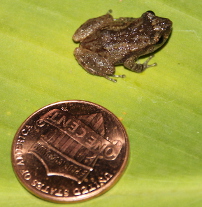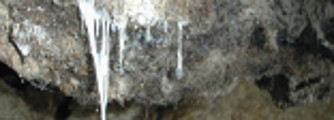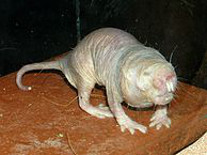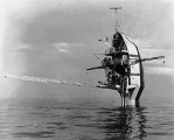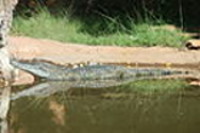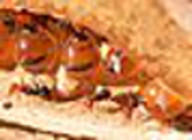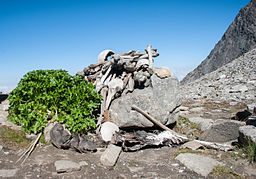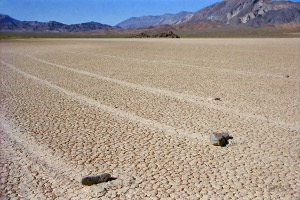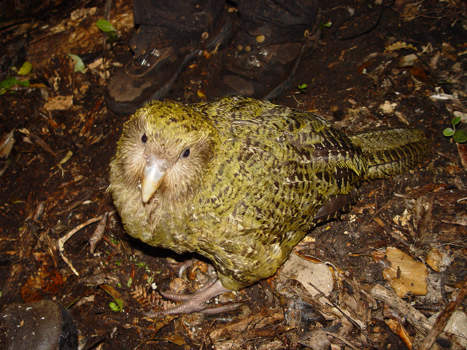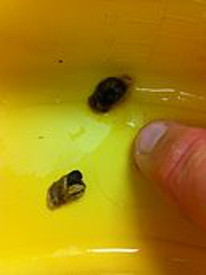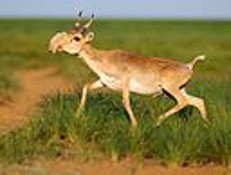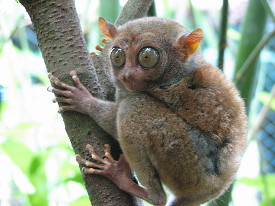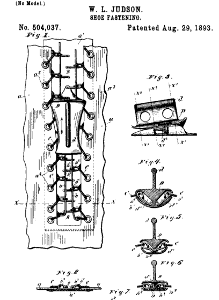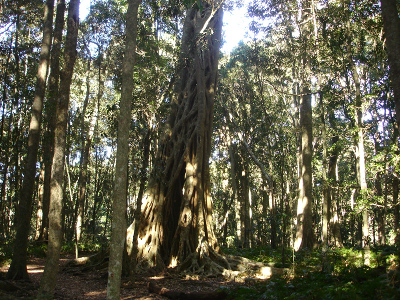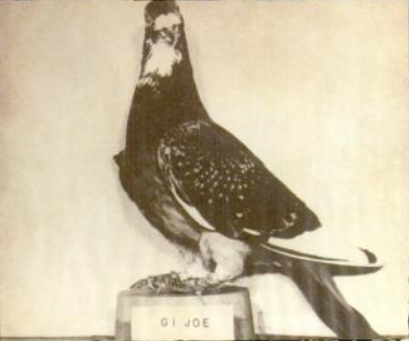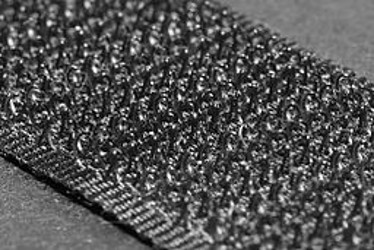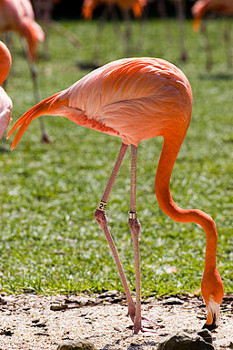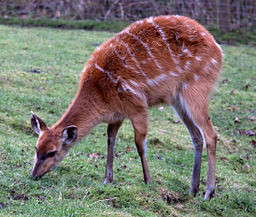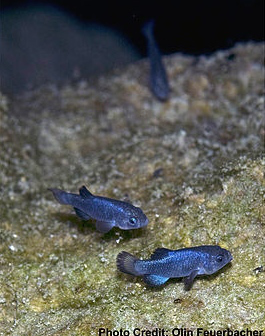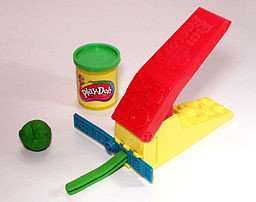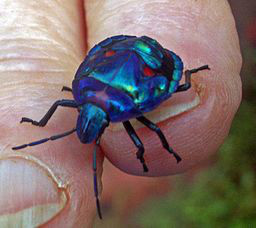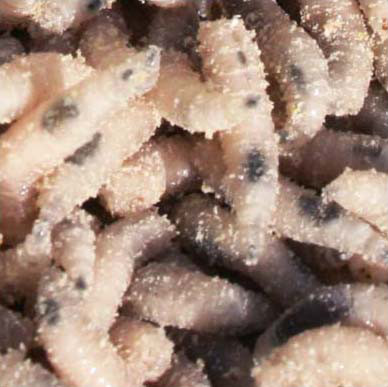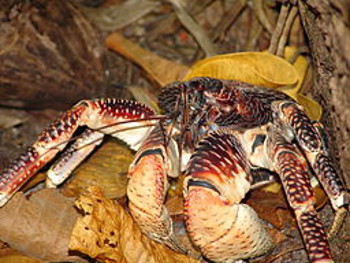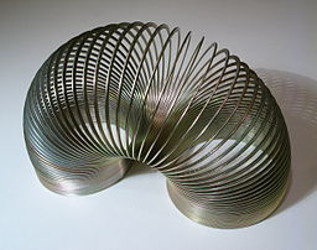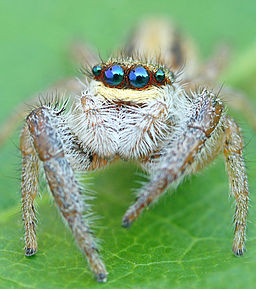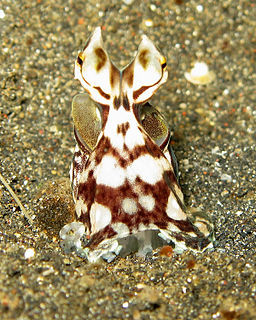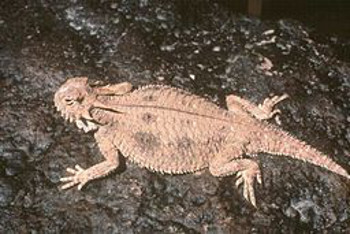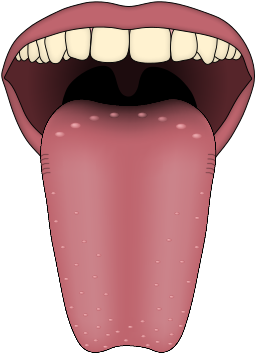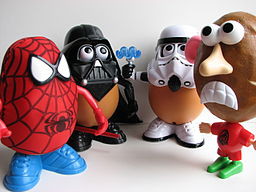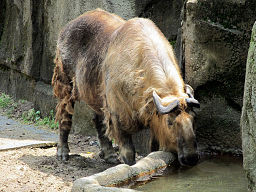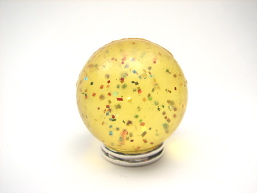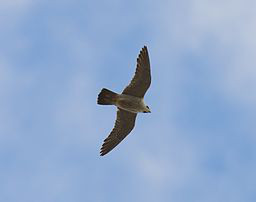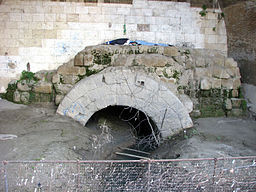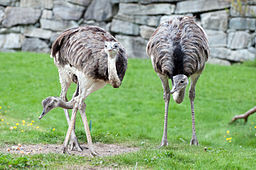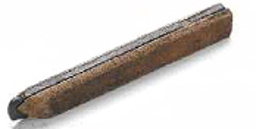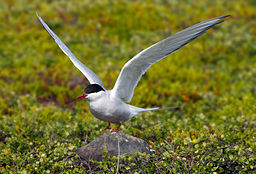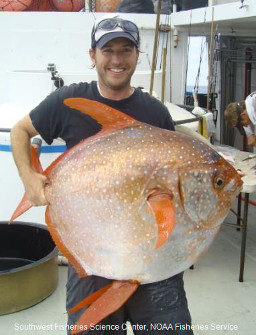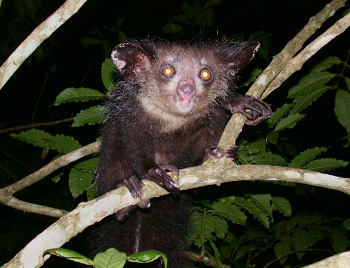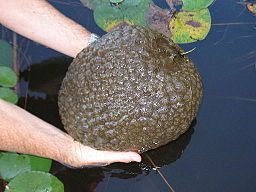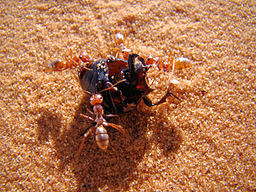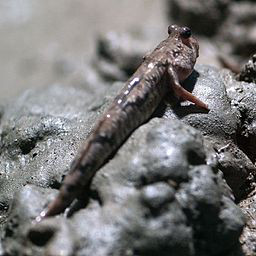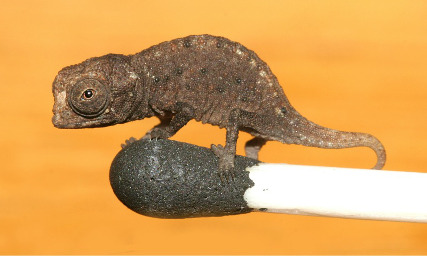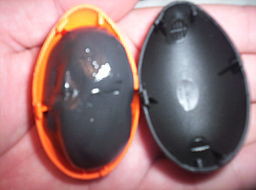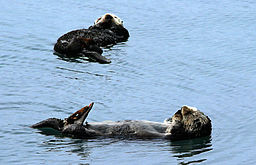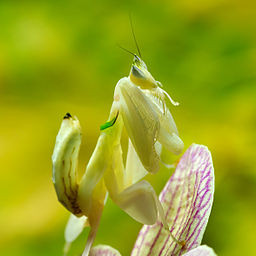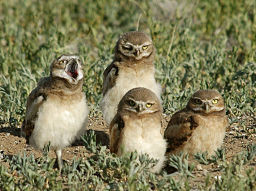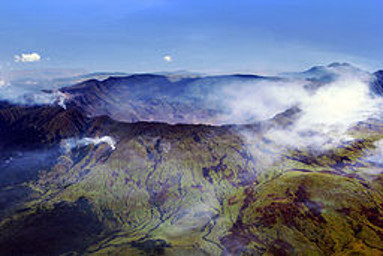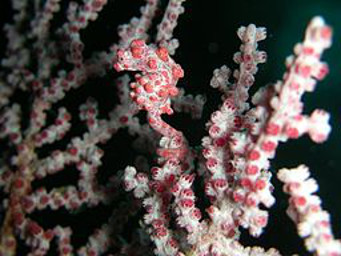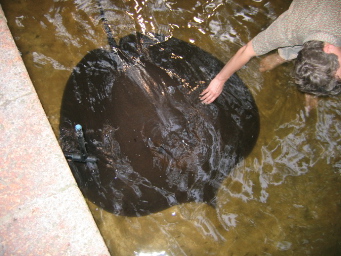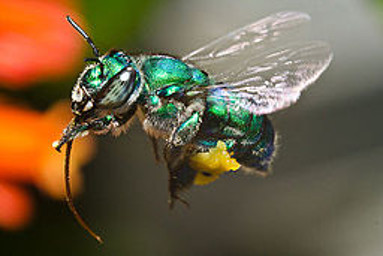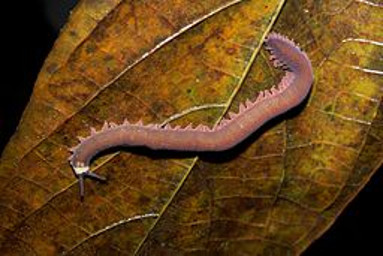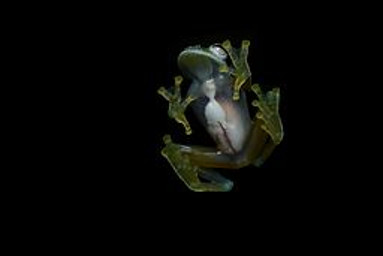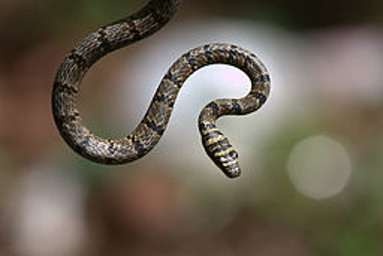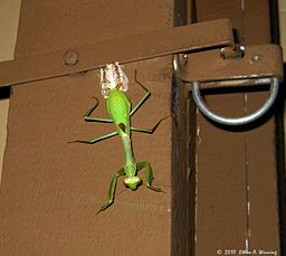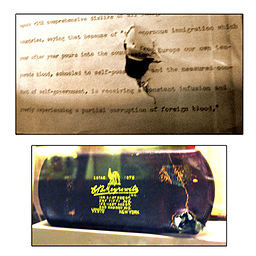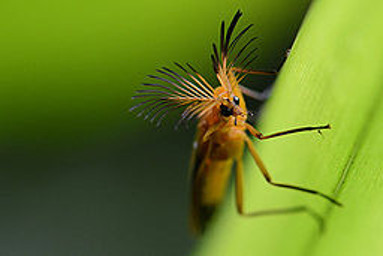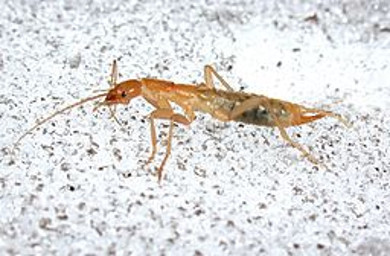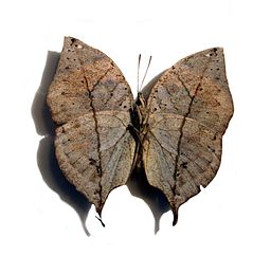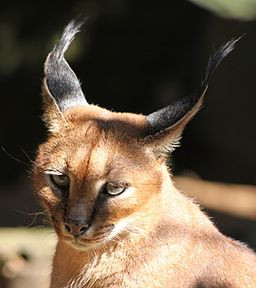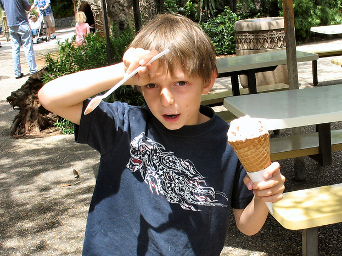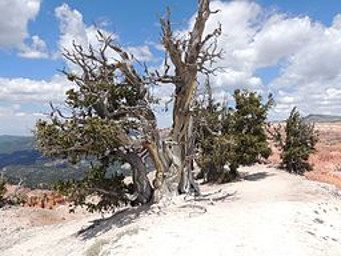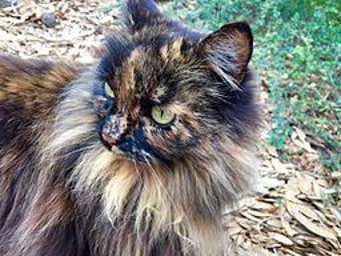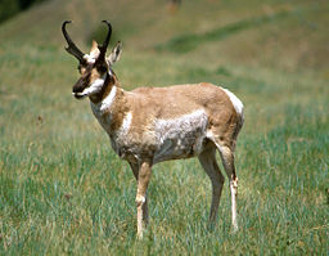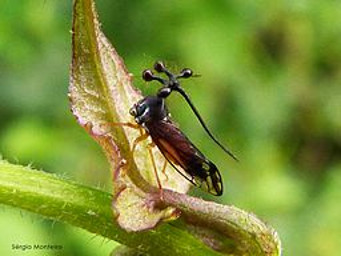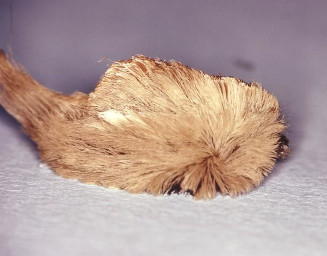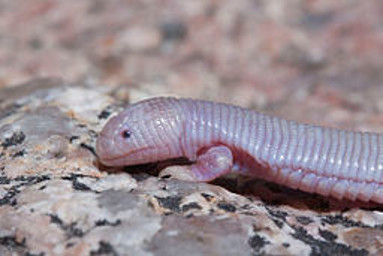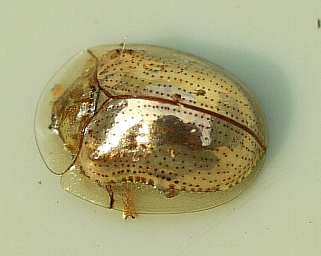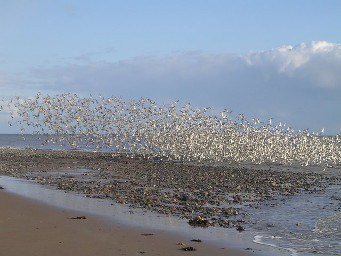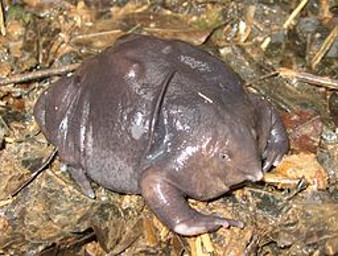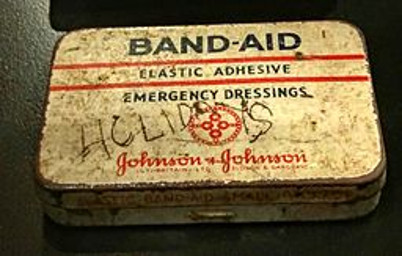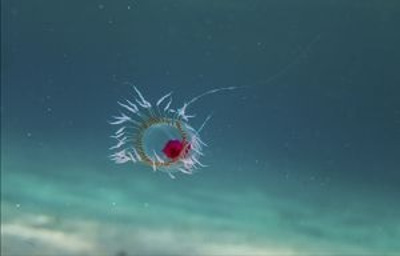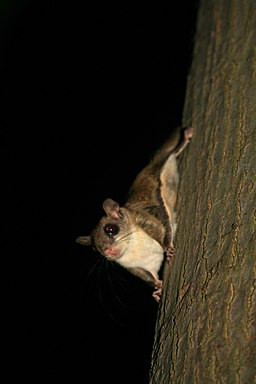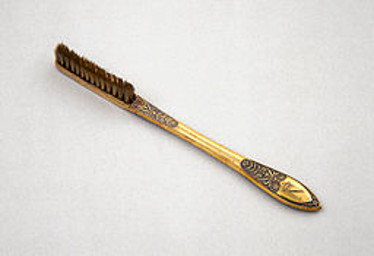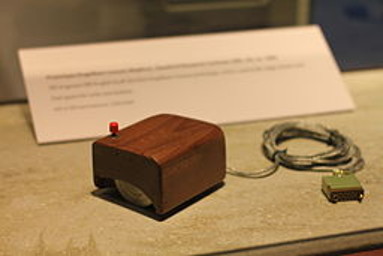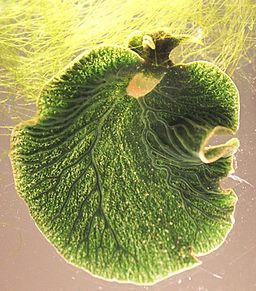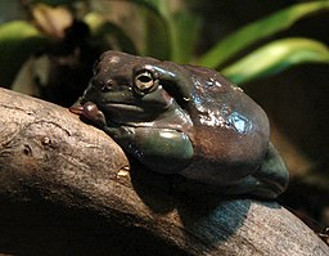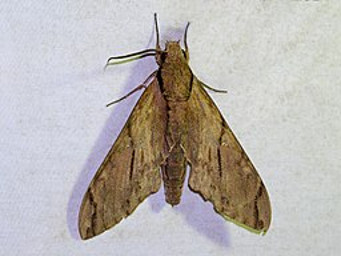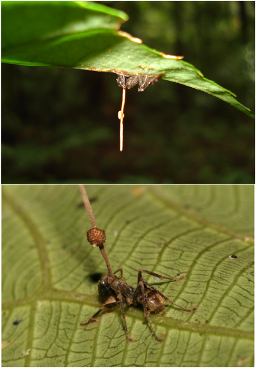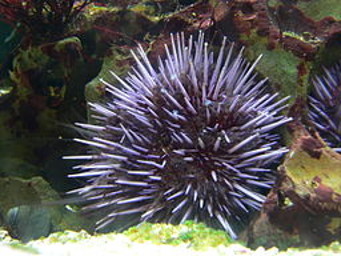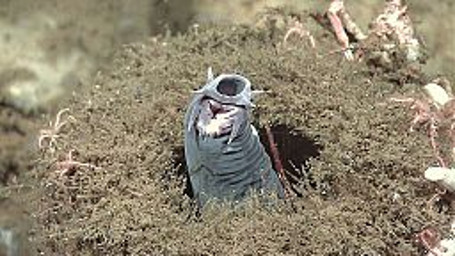
Scroll down to find all previously posted Strange But True Facts.
Of course it is not true that it “rains cats and dogs.” But did you know it sometimes does rain frogs? No, not because they are caught up in tornadoes or hurricanes, although that happens, too.
When humidity gets especially high in the El Yunque National Forest in Puerto Rico, tiny Coqui frogs climb to the top of the rainforest canopy, as much as 100 feet above the forest floor. Along the way, tarantulas and other predators gobble them up. But the survivors leap for their lives! Measuring less than two inches long and weighing only two to four ounces, the Coquis land unharmed in the leafy clutter below. If you happen to be in the right place at the right time, it will indeed rain frogs!&
#40PHOTO:wikicommons:Cathybwl/CC-BY-SA-3.0)
Links...US Forest Service
You’ve probably heard of stalactities in caves, but have you ever heard of snottites? No, they aren’t coming from bat noses! Like stalactites, snottites are also found in caves and do hang from the ceiling, but they are alive!! They are actually colonies of single-celled bacteria that drip from the ceiling and have the consistency of…well, snot. So if you go spelunking (a cool word for exploring caves), watch out for the snottites.
(PHOTO:commons.wikimedia.org Public Domain)
Links...NASA
Riddle: What animal looks like a bratwurst with teeth and a tail, has a queen who bears all the children, and is naked and blind?
Answer: The naked mole rat that lives in Africa.
It’s naked?! Yes. Because it lives underground where the temperature is always about the same, it does not need fur.
It’s blind?! Yes. A naked mole rat has no eyes at all, only eye openings.
But what’s even stranger is that it is the only known mammal living in a eusocial society. What’s that, you ask? Each member of the colony has a special task. Only bees and ants are known to live in this way.
In the naked mole rat world, one dominant female, the queen, produces all the young. All others are either soldiers who remove dirt from the underground tunnels and ward off predators, or workers who dig the tunnels, gather tubers and roots for all to eat, and build nests for the queen. Without eyes, the workers depend on their sense of smell to find food.
(PHOTO:commons.wikimedia.org "Nacktmull" by Roman Klementschitz, Wien-Own work.)
Links...St Louis Zoo
What kind of ship is as long as a football field including both endzones, has no engine or sail, and is flooded on purpose?? The Flip Ship. Okay, so it doesn’t exactly look like a ship and behaves more like a buoy.
FLIP (FLoating Instrument Platform) is an ocean research vessel that belongs to the U.S. Office of Naval Research. It is towed to a site, where its empty hull can be filled with seawater, causing the stern to sink as the bow rises into an upright position. It is used to take accurate oceanographic measurements, such as in the study of waves. In order to do that, a vessel is needed that can maintain its position; that will not be moved around by the waves themselves.
Scientists study onboard for 30-45 days. Because it must function both horizontally and vertically, some of the rooms’ features are built on swivels. Things that won’t rotate well are built on two walls and most rooms have two doors.
Click on the youtube link below to watch the Flip flip. Watch it all the way to the end to see things swivel into place.
(PHOTO:commons.wikimedia.org Public Domain.)
Links...youtube
The desert crocodile of the southern Sahara Desert in Africa has a neat trick.
Wait a minute. What is a crocodile doing in the desert? Don’t they usually hang out along riverbanks in tropical climates?
Usually. But this one lives smack in the desert. During the hottest months, it enters caves, or burrows underground, and lies dormant until the rainy season. Is it hibernating? No! It is estivating. Hibernation is the word used for the state in which animals survive winters. Estivation is the word used for a similar condition in which creatures survive sweltering summers where there is not much water.
When the rains come, creating ponds in hollowed out areas, the desert crocodile becomes active again.
(PHOTO:By cliff1066TM)
Links...youtube
You may not be able to cheat death but there may be a way to “live forever,” in a way. For a mere $5,000-$20,000 you can have your ashes turned into a diamond after you die. Two different companies offer to take one pound of your cremains and put them under intense heat and pressure like the Earth does to make natural diamonds. Unlike the Earth, this man-made process only takes weeks instead of eons. The result is a dazzling gem that your loved ones can cherish in your memory.
If you think this is weird, during the Victorian era (mid-late 1800s) people often took hair from the deceased and incorporated it into jewelry. Examples of mourning jewelry are found in The Metropolitan Museum of Art in New York City as well as in other museums. Not quite as snazzy as a diamond!
(PHOTO:"Diamond" Licensed under Creative Commons Attribution 1.0 via Wikimeida Commons)
Links...NPR
How would you like to be your family’s source of food? No, you would not get all the grocery money. You would become a food container.
That’s exactly what happens in honeypot ant colonies, found in dry environments in Western America, Mexico, Australia, South Africa and New Guinea. Certain members eat all the time, fed constantly by their fellow ants. Their bodies convert everything into a sweet liquid which engorges their abdomens. They hang from the ceiling, serving as nutrition dispensers for the entire colony, regurgitating the stored food whenever another ant needs it. Ah, what a life. Burp!
Click on the youtube link below to find out much more. Be sure to watch the three minute video all the way to the end to see Sir David Attenborough at his finest!
(PHOTO:By Greg Hume, modificada por Aurélio A. Heckert ([Image:HoneyAnt.jpg Wikipedia Inglês]) [CC-BY-SA-3.0 (http://creativecommons.org/licenses/by-sa/3.0)], via Wikimedia Commons)
Links...youtube video
Nearly 16,000 feet up, tucked away in the Himalaya Mountains of India, is a lake that is frozen for eleven months of the year. When it thaws, it reveals a shocking sight, the skeletal remains of at least two hundred humans who seem to have died all at the same time. What happened? Was it a landslide, a fierce battle, or a deadly disease?
Since 1942, when a British forest ranger stumbled upon the bones, the mystery of Skeleton Lake has been unsolved. In the early 2000s, a group of scientists trekked to the remote area to collect samples of the 1200 year old bones. They performed extensive testing and analysis to determine the cause of death. What they concluded will surprise you!
Click on the link below to find out how the scientists think the people died.
(PHOTO:By Schwiki (Own work) [CC-BY-SA-4.0], via Wikimedia Commons)
Links...Skeleton Lake
“Trick or Treat, Smell My Feet.” If someone says this to you on Halloween, Be Afraid! Their feet probably do stink. Maybe it is because feet have about 250,000 sweat glands in the pair. When people wear enclosed shoes, like running shoes or boots, feet stay damp. Not surprising, since the glands of the feet can produce a quart of sweat a day!
That wet environment is a perfect breeding ground for bacteria, and those microscopic stinkers are the real cause for the smell. You won’t need a terrifying costume to get people to flee from you on Halloween; just imprison your feet all day in securely closed shoes with heavy socks, and that should do the “trick.”
Click on the link below to find out more.
(PHOTO:By Brimstone (Own Work) [CC-BY-SA-3.0 (http://creativecommons.org/licenses/by-sa/3.0)], via Wikimedia Commons)
Links...Feet
Everyone knows that rocks can’t move on their own. They are not alive. Then why are there trails in the sand in Death Valley as if rocks have traveled? It happens every now and then in a dry lakebed in the desert, known as Racetrack Playa. There are no footprints to suggest it is a trick, no other marks of any kind. And no human had ever seen the rocks as they slide…until now.
In December, 2013, Richard Norris and his cousin James Norris, who had been studying the phenomenon since 2011, finally observed the event in person. And in January, 2014, they managed to catch the act on video.
Click on the link below to see a time lapse video, and to read an excellent explanation of how the rocks move.
(PHOTO:By Brian W. Schaller (Own work) [FAL], via Wikimedia Commons)
Links...Sliding Rocks
In 1903 Edouard Benedictus knocked a glass bottle of chemicals off a shelf. To his surprise, the bottle cracked all over but did not shatter into tiny pieces and scatter across the floor. Something seemed to be holding the broken pieces together.
The bottle contained cellulose nitrate, which had coated the inside. Benedictus hypothesized that the coating had bonded together the pieces. By accident he had made a discovery that led to coating glass on car windshields to protect passengers from serious cuts in an accident.
Today’s “safety glass” is made by a different method, but the idea is the same. Safety glass is used in all kinds of products besides automobile windshields, including protective eyeglasses, shower doors, skylights, and refrigerator shelves.
Click on the video link below, go to the two minute mark, and find out why the timing of this discovery was important.
(PHOTO:By Tony Hisgett from Birmingham, UK (Shattered uploaded by tm)[CC-BY-2.0 (http://creativecommons.org/licenses/by/2.0)] via Wikimedia Commons)
Links...National Science Foundation
Imagine a parrot. That only comes out at night. That is rabbit-sized. That can weigh two and a half to nine pounds. That nests on the ground. That is flightless, with muscled thighs. This unique bird, the kakapo (kay KAY poe) once flourished in New Zealand by the hundreds of thousands. Now it is dangerously close to extinction. What happened?
New Zealand was once an island with no land mammals, including no people. The kakapo’s natural enemies were only birds of prey. When threatened, they froze in place, using their camouflage coloring to hide.
Eventually, explorers from East Polynesia, the Maori, as they came to be known, settled on the island. They found the birds easy to catch, due in part to their goofy hopping run as well as their tendency to freeze when in danger.
When Europeans arrived in the early 1800s, they brought their dogs and cats, and inadvertently, rats that stowed away on ships. The bird’s population fell rapidly. Today, only about 125 remain! What’s to become of the kakapo?
To find out, follow the link below for a treasure trove of information.
(PHOTO:By Mnolf [GFDL(http://www.gnu.org/copyleft/fdl.html), CC-BY-SA-3.0(http://creativecommons.org/licenses.by-sa/3.0)]via Wikimedia Commons)
Links...Kakapo Recovery
Ear wax. Yuck! While the guys on T.V.’s Mythbusters found it to be useless in making candles, it does perform many important functions inside the ear canal. It coats the “guard hairs,” (yes, there are hairs inside your ear, too. Double yuck!), making them sticky so they can keep out dust and other debris. It waterproofs the ear canal. It keeps the eardrum flexible so it will capture sounds correctly. And it kills some kinds of bacteria and fungi.
Good stuff this ear wax! But where does it come from? Bet you didn’t know you had sweat glands inside your ears. Well, very specialized sweat glands. Let’s see now…wax, hairs, sweat. GROSS.
Follow the link below to get the scoop on earwax.
(PHOTO:By Mark Howard (Own work) [CC-BY-SA-3.0(http://creativecommons.org/licenses.by-sa/3.0)]via Wikimedia Commons)
Links...Kids' Health
When you think of antelope you probably think of a beautiful, lean, graceful animal. There is one kind of antelope, however, with a face only a mother could love.
The saiga (SI guh) has a long, inflatable, humped, moveable nose that hangs over its mouth, especially noticeable on the males. It runs head down (from the weight of that nose?), reaching 50 mph. A migratory animal, the saiga once roamed all over Europe and Asia. Now it lives only on the dry, grassy steppes of Central Asia.
The crash in its population is a modern day example of human-driven decline. When the Soviet Union fell apart, protection from poaching ended. In only fifteen years the saiga population plummeted by 95%! Like many other animals (rhinos, elephants), they were slaughtered for their horns, prized as an ingredient in traditional Chinese medicines. Now, the saiga is considered a critically endangered species.
But what’s with that nose? It is an adaptation to the extremely cold and dusty environment in which the saiga lives. In the summer, it keeps dust out and in the winter, it warms icy air before entering the lungs. It may not be pretty, but the saiga’s nose helps the animal survive.
Click on the video link below to see these animals in action.
(PHOTO:By Seilor (www.ulytautour.kz) [CC-BY-SA-3.0(http://creativecommons.org/licenses.by-sa/3.0)]via Wikimedia Commons)
Links...Saiga Antelope
Historic snowstorms recently belted the northeastern United States in November, 2014. But did you know that one winter two massive blizzards in the U.S. killed thousands of people? The two storms are often confused with one another.
On January 12, 1888, a blizzard suddenly struck the northern Great Plains just as children were walking home from their one-room schools. Very quickly, whiteout conditions enveloped the countryside. Children lost their way and as the temperatures plunged below zero, many died in what became known as “The Children’s Blizzard.”
Just two months later, another rapidly developing storm hit the East Coast on March 11. It lasted through the 14th and paralyzed the region. As snow accumulated on the tracks, trains came to a standstill and people abandoned them to walk to the cities. Many of those passengers died along the way. Other people trying to walk to work within the cities also perished. The terrible storm left fifty foot snowdrifts in its wake and the strong winds accompanying “The White Hurricane” sank 200 ships off the coasts from Maryland to Canada.
Click on the links below for amazing historic photos.
(PHOTO:This image may be used freely throughout Wikipedia. [CC-BY-SA-2.5 (http://creativecommons.org/licenses/by-sa/2.5)], via Wikimedia Commons)
Links...Children's Blizzard
Links...White Hurricane
Is that a mushroom glowing in your salad? Not likely. But you won’t know unless you eat with the lights out. It turns out there are at least 71 species of mushrooms in the wild that actually glow in the dark. Scientists discovered seven new ones as recently as 2009.
Bioluminescence, the production of light by a living organism, is found in a variety of life forms such as the lightning bug (firefly). It is most common in ocean creatures, like certain jellyfish. It may serve to attract a mate, attract prey, warn away predators, or as camouflage.
So why do these mushrooms glow? The species with this trait are not poisonous and they aren’t attracting mates or prey. Researchers must continue studying them to understand the value of bioluminescence in mushrooms.
Click on the link below to see more spectacular photos.
(PHOTO:By Thomas Schoch (top image); Noah Siegel (Amanita virosa) (bottom image) [CC BY-SA 3.0 (http://creativecommons.org/licenses/by-sa/3.0)], via Wikimedia Commons)
Links...Glowing Mushrooms
The bird dropping spider, found in Australia, is one sneaky animal. Since birds are its main threat, this spider sits still throughout the day looking like a heaping pile of bird doo-doo (bird droppings). Well, birds aren’t going to eat that!
Also smelling a bit like poo, the spider attracts flies and snatches them for food. But it is at its most devious at night. While hanging by a silk thread, forelegs outstretched, it releases a female moth's scent (pheromone) that attracts male moths. The love-struck moth is grabbed, not in an embrace, but in a death grip, and is eaten by the spider.
Thanks to my friend Amy for this fascinating subject!
Click on the links below to see a video and to read more about this master of disguise.
(PHOTO:By Poyt448 Peter Woodard (Own work) [CC BY-SA 3.0 (http://creativecommons.org/licenses/by-sa/3.0)], via Wikimedia Commons)
Links...youtube video
Links...Australian Museum
You think you see a flying saucer. It is white and hovers near a mountain. Are we about to be invaded by aliens?! Don’t call 911!
Most likely, what you see is an unusual cloud known as an Altocumulus Standing Lenticular Cloud (ACSL) or just a lenticular cloud. They usually form near mountaintops, and seem to stay in place.
They seem to be stationary because moisture continuously rebuilds on one side, while evaporating on the other. Their hovering appearance often causes an increase in reports of UFOs from those unfamiliar with the phenomenon.
While lenticular clouds are interesting to observe, airlines try to route jets around them as they can be a source of dangerous turbulence.
Click on the links below for ACSLs caught on video and for the science surrounding how they form.
(PHOTO:By Acaro (Own work) [CC BY-SA 3.0 (http://creativecommons.org/licenses/by-sa/3.0) or GFDL (http://www.gnu.org/copyleft/fdl.html)], via Wikimedia Commons)
Links...youtube video
Links...NOAA
Primates include humans, apes, monkeys…and tarsiers; shy, elusive animals with bat-like ears that are only six inches long! Nocturnal and arboreal (living in trees) they are found only on islands in Southeast Asia. At night they communicate with one another, sounding like chirping birds.
A tarsier is the only entirely carnivorous primate on Earth, eating no plant matter at all. How does the tarsier find and capture its prey?
It clings to branches with its sticky toe pads, relying on its exceptionally large eyes and keen sense of hearing to locate insects, lizards, and even small birds. It has the largest eyes of any animal in comparison to its size. Unfortunately, the tarsier’s eyes are so big they cannot rotate, but fortunately it has the ability to turn its head 180° in both directions to see all around it.
When a tarsier detects a possible meal, it jumps as much as forty times its length to snatch it. You’d have to leap the distance of three or four semi-trailer trucks parked end-to-end to match that feat!
Click on the links below to read about these primates, and to watch a two-minute video of one successfully hunting in its nighttime world. Remember, it is only six inches long.
(PHOTO:By mtoz (originally posted to Flickr as Tarsier) [CC BY-SA 2.0 (http://creativecommons.org/licenses/by-sa/2.0)], via Wikimedia Commons)
Links...ARKive video
Links...Tarsier Foundation
One of the most amazing new inventions at the Chicago World’s Fair in 1893 was the very first Ferris Wheel; 264 feet high, with thirty-six cars each able to hold sixty people! Those planning the fair wanted an attraction to rival Paris’ Eiffel Tower that had dazzled the world at the 1889 World’s Fair. It would be hard to beat. When George Ferris proposed his wheel, fair board members did not believe it could stand up and revolve under its own massive weight.
They were wrong! Ferris and his family took the first ride to prove it was safe. During the fair, more than 1.5 million people followed their example, hopping on board to enjoy an unparalleled view of the city.
Whatever happened to that spectacular wheel? Click on the link below to find out. Scroll down to V. The Last Days.
P.S. Come back next week to find out about another invention introduced at the Chicago World’s Fair in 1893 that, though much tinier, turned out to be much more important in the course of history.
(PHOTO:By Not given [Public domain], via Wikimedia Commons)
Links...Hyde Park History
Another invention that made its debut at the 1893 Chicago World’s Fair, failed to impress attendees nearly as much as last week’s subject, the Ferris Wheel. But it turned out to have lasting value in everyday life.
Whitcomb Judson’s invention, the “clasp locker,” was two sets of interlocking teeth that could be joined and separated with a simple pull. The new invention was first used on rubber boots and for tobacco pouches.
Over time it was improved and renamed. You probably used one today!
Click on the link below in LEARN MORE to find out if you’ve guessed what it is.
(PHOTO:By US Patent Office [Public domain], via Wikimedia Commons)
Links...Invention
The strange axolotl (AX uh lah tul) is an amphibian that never looks quite grown up. While most frogs and salamanders change from tadpoles into their adult forms in a process called metamorphosis (met uh MOR fuh sus), the axolotl appears stuck in its “tadpole” stage. And unlike most other amphibians which live on both land and water, the axolotl lives exclusively in the water.
Found in the wild only in and around Lake Xochimilco (SO chee MILL ko) near Mexico City, this critically endangered salamander species suffers from loss of habitat and water pollution. So they are kind of cute, but what are they good for?
Because an axolotl lives happily in a lab, scientists have studied it for years for its ability to grow new body parts. Besides regenerating limbs or a tail, the axolotl can also renew parts of its brain and spinal cord. Researchers hope to unlock this prehistoric-looking animal’s secrets to help people with spinal cord injuries regain movement.
Click on the links below to see living, moving axolotls and to LEARN MORE.
(PHOTO:By Erzengel (Own work) [Public domain], via Wikimedia Commons)
Links...Kids Nat. Geo.
youtube video
The strangler fig is a lousy guest. It begins life as a sticky seed left behind in the canopies of other tree species by monkeys, birds, or bats. Capturing moisture from the air, power from the sun, and nutrients from debris on the tree where it rests, it thrives in tropical forests all around the world. It is an epiphyte (EP uh fite), a plant that simply perches upon another plant, like some mosses, orchids, and algae. Unlike a parasite, it does not steal nutrients directly from the tree.
Growing fast, the strangler fig sends its massive root network all the way down to the forest floor. Once the roots take hold in the ground, the fig does begin competing for food with the original tree. See for yourself how this strange plant lives up to its name in an amazing time-lapse video showing its life from seed to mature tree.
Click on the links below to LEARN MORE and to view the YouTube video.
(PHOTO:By MagpieShooter (Own work) [GFDL (http://www.gnu.org/copyleft/fdl.html), CC-BY-SA-3.0 (http://creativecommons.org/licenses/by-sa/3.0/) or CC BY-SA 2.5-2.0-1.0 (http://creativecommons.org/licenses/by-sa/2.5-2.0-1.0)], via Wikimedia Commons)
Links...Cal Tech
youtube video
What if I told you the world’s most famous video game company has been in business since the 1800s? Since home computers are a very recent invention, that’s simply not possible. Oh, but it is. The company we all know as Nintendo has been around that long!
Originally, the company was named Marufuku and it made Japanese playing cards. In 1907, it began making playing cards for the rest of the world; think Crazy Eights and Go Fish. Then, in 1963, it changed its name to Nintendo and eventually entered the video game market. Strange but true!
Click on the link below to LEARN MORE for details.
(PHOTO:By TarkusAB (Own work) [CC BY-SA 3.0 (http://creativecommons.org/licenses/by-sa/3.0)], via Wikimedia Commons)
Links...Nintendo
Wombats, found in Australia, are marsupials like kangaroos and their close relatives koalas. Wombats have some of the cutest scat you will ever see. It is cube-shaped. That’s right, when they have the urge to go they leave behind poo shaped like dice.
These animals may be short and pudgy but don’t let that fool you. They can run up to 25 mph when they need to, as fast as a car drives through a neighborhood.
Like all marsupials, each mother has a pouch, but there is something different about a wombat’s. It opens near the mama’s rear instead by her front legs. Why?? Wombats do a great deal of digging and tunneling. If the pouch opened like a kangaroo’s, it would fill with dirt!
Find out about these adorable animals by clicking on the links below. Don’t miss the video!
(PHOTO:By JJ Harrison (jjharrison89@facebook.com) (Own work) [CC BY-SA 3.0 (http://creativecommons.org/licenses/by-sa/3.0)], via Wikimedia Commons)
Links...Nat Geo
YouTube video
World War II. American forces had requested an air attack on the Germans who held the town of Colvi Vechhia, Italy. When the Germans unexpectedly retreated, British soldiers headed into the town to take control, unaware that American planes were preparing to take off.
Nearby American troops, knowing the British soldiers would be bombed by mistake, were unable to contact their base and call off the attack. Telephones were unavailable and their radio transmissions were not getting through. How could this disaster be avoided?
G.I. Joe saved the day and for his “devotion to duty” he received the Dickin Medal. However he was not a soldier. He was a carrier pigeon!! And strapped to his leg in a tiny capsule was the message that arrived just moments before the bombers took to the skies.
Thanks to my good friend Wendy for suggesting this subject.
To find out more about how G.I. Joe saved the troops and to see a video of him receiving his medal, click on the links below.
(PHOTO:By United States Department of Defense/Army Fort Monmouth Historical Office [Public domain], via Wikimedia Commons)
Links...GI Joe
YouTube video
Maybe you’ve heard the saying “slow as molasses in January.” But one January day in history, molasses wasn’t slow and it wasn’t being poured from a bottle.
In Boston, on January 15, 1919, a five-story tall tank burst holding nearly two and a half million gallons of molasses. A sweet, brown, syrup-like eight-foot high tsunami tore through the streets devastating everything in its path.
Houses collapsed, steel girders on the Boston Elevated Railway gave way, and electrical poles snapped. It swept 21 unsuspecting people to their deaths and injured 150.
Click on the History.com link below in LEARN MORE for details. To view historic photos of the disaster click on the youtube video link and watch from the 3:30-4:05 mark.
(PHOTO:See page for author [Public domain], via Wikimedia Commons)
Links...History.com
YouTube video
Under the leafy litter on the floor of Earth’s northernmost forests, sits an icy stone resembling a frog. It is a frog! Frozen solid! It does not move, breathe, or have a heartbeat. But it is alive.
Click on the links below in LEARN MORE to read about how the Arctic wood frog performs this miracle, and to view a short time lapse video of the frog in action…or is that inaction?
(PHOTO:By Ontley (Own work) [CC BY-SA 3.0 (http://creativecommons.org/licenses/by-sa/3.0)], via Wikimedia Commons)
Links...National Geographic
YouTube video
After pulling sticky burrs out of his Irish Pointer’s fur, George de Mestral, an engineer, decided to find out what made them stick so stubbornly. He found that the outside of the seedpod was covered in tiny hooks.
He got an idea and set out to copy the design. Although many laughed at him, de Mestral’s invention eventually turned into a multi-million dollar industry producing Velcro!
Click on the link below to LEARN MORE.
(PHOTO:By Alexander Klink (Own work) [CC BY 3.0 (http://creativecommons.org/licenses/by/3.0)], via Wikimedia Commons)
Links...Inventors
One animal feeds with its head upside down, and is pink because of what it eats. The flamingo leans all the way over, swinging its upside-down head back and forth through the water, trapping crustaceans, mollusks, and insects with a built-in filter.
It can do this because its beak is built the opposite of other birds’. Instead of having a moveable lower jaw like most species (including humans), its upper jaw is the one that moves.
Click on the links below to LEARN MORE and to see a video of these animals eating.
(PHOTO:By jimmyweee (Feasting Uploaded by russavia) [CC BY 2.0 (http://creativecommons.org/licenses/by/2.0)], via Wikimedia Commons)
Links...Stanford
Links...youtube video
You may want to mute the video.
Albert Einstein is well-known as a genius. But did he nearly become a politician? It is widely reported on the Internet that Chaim Weizman, Israel’s first president, asked Albert Einstein to follow him as the next president.
There’s one problem with that claim. Weizman was already dead when Einstein received this request!
Click on the link below in LEARN MORE to read the actual letter sent to Albert Einstein, to find out who sent it (it wasn’t Weizman!), and to discover Einstein’s reply.
(PHOTO:By Photograph by Oren Jack Turner, Princeton, N.J. Modified with Photoshop by PM_Poon and later by Dantadd. [Public domain], via Wikimedia Commons)
Links...Library
One of Africa’s semiaquatic mammals is a small antelope. While many animals use camouflage to avoid predators, the sitatunga that lives in muddy swamps and marshes in central Africa, has an entirely different trick. To survive hungry lions, leopards, hyenas, and wild dogs, it goes underwater leaving only its eyes and nose above to watch for danger and to continue breathing.
Click on the links below to read about this unusual animal, and to view it in its natural habitat.
(PHOTO:By Tony Hisgett from Birmingham, UK (Sitatunga Uploaded by tm) [CC BY 2.0 (http://creativecommons.org/licenses/by/2.0)], via Wikimedia Commons)
Links...UMichigan
Links...YouTube
Scroll down below main photo. Choose videos. Click on 1/4.
There’s more than a tail trailing that comet. Recently a robotic probe named Philae landed on a moving comet! In the meantime, the mothership that had dropped Philae whizzed by and analyzed the fuzzy cloud surrounding the streaking chunk of dirty ice.
And the tail stinks! Several offenders have been detected: hydrogen sulphide, that smells like rotten eggs; ammonia, for that horse stable aroma; and sulphur dioxide, that adds a whiff of vinegar. It’s a good thing Philae doesn’t have a nose. Oh, and by the way, the comet also sings.
Thanks to my good friend Lisa for suggesting this strange but true fact.
Click on the links below to read about what scientists hope to discover from this comet, and to hear its song.
(PHOTO:By NASA [Public domain], via Wikimedia Commons)
Links...NASA
Links...Audio
If you saw a fish in the desert, you might think it was a mirage. But they really are there.
When Ice Age lakes dried up, that once covered much of the U.S. Southwest, small pockets of water remained. In one, Devil’s Hole, lives an iridescent blue, inch-long pupfish, the only place on Earth it exists. This isolated lake in Nevada plunges to a depth greater than the length of a football field. In fact, divers have never found the bottom.
Only about 35-150 Devil’s Hole pupfish survive in the upper eighty feet of the lake. Despite having adapted to 93° water that would kill most fish and would make you sweat, this species continues to be in extreme danger of extinction.
Click on the links below to find out how the pupfish might make a comeback with the help of scientists.
(PHOTO:By U.S. Fish and Wildlife Service Headquarters [CC BY 2.0 (http://creativecommons.org/licenses/by/2.0)], via Wikimedia Commons)
Links...US Fish and Wildlife Service
Links...YouTube
Playdoh started life as a wallpaper cleaner. Kutol Industries sold the stuff and the company thrived. That is, until home furnaces changed from coal-burning to oil or natural gas. Sticky coal residue vanished. Homeowners didn’t need the cleaner anymore. Kutol faced financial ruin.
Joe McVicker took over the task of rescuing the company. His sister-in-law read about how to model Christmas ornaments out of the pliable wallpaper cleaner. She tried it with the preschoolers in her school and it worked! With a few tweaks to the original recipe and a new name for the product, the family launched it as a toy. As the saying goes “the rest is history.” Over 2 billion cans have been sold.
Click on the links below to read about how this product accidentally became a toy and to view a dramatization of its history on video.
(PHOTO:By Larry D. Moore [CC BY-SA 3.0 (http://creativecommons.org/licenses/by-sa/3.0) or GFDL (http://www.gnu.org/copyleft/fdl.html)], via Wikimedia Commons)
Links...Toy Hall of Fame
Links...Video
The tarantula hawk isn’t a spider or a hawk, but the females are fierce predators. A two-inch long metallic midnight blue insect with orange wings, the tarantula hawk is a wasp. For humans, this wasp’s sting is considered to be one of the most painful, described by some as “blinding and debilitating.” Except for the pain, it is mostly harmless to people.
For the unsuspecting tarantula, it is a different story. In the fall, the female wasp hunts them down one at a time, but not to kill them. The two fight, and if she stings the tarantula, her poison paralyzes the spider. She is then free to drag the helpless creature to a burrow, where she lays a single egg on it.
The spider, still alive, remains paralyzed and fresh, as if refrigerated, until the larva develops three to four days later. The larva feasts, finally spins a cocoon, and emerges as an adult the following spring.
Click on the links below to read about this remarkable insect and to view a two-minute video of one female triumphing over a tarantula.
(PHOTO:By Astrobradley (Own work) [Public domain], via Wikimedia Commons)
Links...National Park Service
Links...Tucson Weekly Video
Imagine shopping in a tunnel-like downtown district where to cross the street you had to go to the corner, climb a 12-30 foot tall ladder, walk to the other side, and then climb down. This is exactly what you would have experienced in Seattle around the turn of the 20th century.
After a major downtown fire, city leaders decided to level out the steep landscape by raising the streets there and whittling down some of the nearby hills. This also solved two problems: frequent tidal flooding and the backup of indoor toilets that accompanied it.
Unfortunately, before any surviving storefronts could move upstairs into their future first floors, the city ran out of money to complete the ambitious engineering feat. People had to climb to cross the street. It took nine years to complete the new city on top of the old.
Today, visitors take an Underground tour to walk through the original infrastructure. They gaze overhead through purple glass-block skylights now embedded in the city’s sidewalks that once let light into basements.
Click on the link below to find out what shut down Seattle’s Underground completely in 1907 until an entrepreneur rediscovered it in the 1960s.
(PHOTO:By Shakespeare at en.wikipedia [Public domain], from Wikimedia Commons)
Links...LA Times Article
The snails most of us know, clean our aquariums or slither silently through our gardens. They are quarter-sized or smaller. Harmless, right?
Not necessarily. In moist high-altitude forests in New Zealand, the Powelliphanta is super-sized and carnivorous! It grows as large as a man’s fist and weighs as much as ninety grams, about the weight of 100 Skittles™. Nocturnal, they hunt down earthworms, sucking them up like spaghetti. They must be excellent predators, because they can live for twenty years.
Thanks to my friend, Amy, for alerting me to carnivorous snails.
Click on the link below to read about the Powelliphanta’s unusual hard-shelled eggs. Be sure to scroll to the bottom of this page for a one-minute video of a Powelliphanta attacking an earthworm. Yes, attacking. Wait until you see it!
(PHOTO:By Alan Liefting (Own work) [Public domain], via Wikimedia Commons)
Links...Kiwi Conservation Club
Have you ever eaten turducken? You know, chicken, inside a duck, inside a turkey. Well, whether you have or haven’t eaten this unusual main course, rich ancient Romans sometimes feasted on a dish that was a chicken, stuffed inside a duck, inside a goose, inside a pig, inside a cow!
The image at the right is turducken, which takes four to five hours to bake. How long could that Roman concoction have taken? And what did they call it? A cowigooducken??
Click on the link below to LEARN MORE.
(PHOTO:By User Zerokaneda on en.wikipedia [Public domain], via Wikimedia Commons)
Links...History For Kids
Where there is smoke there is fire, and the smart thing to do is flee. Then why does the jewel beetle, Melanophila, head straight for a forest fire?
Found all over the world, this jewel beetle, sometimes called a fire-chaser or fire beetle, must lay its eggs on freshly burnt timber. The larva feast on the nutrition-filled phloem of the defenseless trees, a layer just under the bark.
But Melanophila doesn’t just hang around an area waiting for it to burst into flames. She has two body parts that help her detect fires as far away as thirty to fifty miles. One is an infrared sensor on her underside that detects heat, and the other is her antennae that detect miniscule amounts of substances present in smoke. When those two alarms go off, she flies in.
Click on the link below to LEARN MORE.
(PHOTO:By John Hill (Own work) [GFDL (http://www.gnu.org/copyleft/fdl.html) or CC BY-SA 4.0-3.0-2.5-2.0-1.0 (http://creativecommons.org/licenses/by-sa/4.0-3.0-2.5-2.0-1.0)], via Wikimedia Commons)
Links...NewScientist
Eew! Maggots! What is grosser than a mass of squirming white larva swarming within a wound on a still-living animal? We all know they play an important role in nature as scavengers, but despite their grossness they have some important medical uses, too.
In the Civil War, and again in WWI, battlefield docs noticed that wounds infested with maggots healed better than those without. They decided to try maggots on wounds that contained dead tissue, since it is only necrotic tissue the maggots feed upon. Clearing out the decomposing cells often prevented the onset of gangrene (the death of more nearby live tissue), and saved some soldiers from amputations.
By the 1940s, due to the discovery of numerous antibiotics, the use of maggots fell out of favor as a “barbaric” treatment. But in recent decades, as antibiotic-resistant bacteria have flourished, some doctors are once again turning to the lowly maggot for help.
DO NOT TRY THIS AT HOME! Medical maggots are a particular species grown in labs and approved for use by the FDA (Federal Drug Administration). Physicians carefully monitor how many maggots are used and how long they are left in the wound.
Click on the link below to find out how the maggots work their magic.
(PHOTO:By Andrew Barker (Own work) [CC BY-SA 3.0 (http://creativecommons.org/licenses/by-sa/3.0) or GFDL (http://www.gnu.org/copyleft/fdl.html)], via Wikimedia Commons)
Links...Scientific American
Usually arthropods (insects, spiders, and crabs) are small with a short life span. But there is one crab that can live for forty to one hundred years, weighs as much as a small to medium dog, and has a well-developed sense of smell. The coconut crab has a leg span of three feet and can tip the scales at nine pounds. Think Alaskan King Crab, but super-sized!
The coconut crab’s name comes from the fact that it can open coconuts. In a process that can take days, it will pull fibers from the outer shell, use its longest walking leg to puncture through the eyes of the coconut, and then pry it open with its massive claws. Sometimes this giant crab drops the coconuts from a tree and then uses its strong pincers to crack it.
Coconut crabs only live on islands in the Indian Ocean and the central Pacific Ocean. While they eat mostly fruit, nuts, seeds, and coconut meat, they will eat carrion. They will also raid trash cans and campsites, making them a fearsome pest.
Click on the links below to learn more and to get a real sense of this giant crab’s dimensions. You need only watch about the first minute of the youtube video.
(PHOTO:By Drew Avery (Coconut Crab {Birgus latro}#3 Uploaded by Amada44) [CC BY 2.0 (http://creativecommons.org/licenses/by/2.0)], via Wikimedia Commons)
Link...Wired
Link...youtube
In 1943, Richard James worked for a shipbuilder, experimenting with ways to keep ships’ delicate onboard instruments level in the shifting seas. He settled on using springs and was in the process of trying different sizes and types, when one fell off a shelf in his office. When it walked down to a pile of books, to his desktop, to a chair, to the floor he took it home to his two-year-old son. Tommy was fascinated.
It was a while before James realized what he had accidentally invented. He borrowed $500, his wife came up with the name Slinky, and they manufactured 400.
They went store to store with the new toy, with little success. However, Gimbel’s Department Store in New York City allowed James to give a demonstration of his product about a month before Christmas 1945. In 90 minutes, he sold out his entire inventory.
Click on the links below to learn more and to view the 1960s TV commercial that launched the Slinky.
(PHOTO:By Roger McLassus (Picture taken and uploaded by Roger McLassus.) [GFDL (http://www.gnu.org/copyleft/fdl.html) or CC-BY-SA-3.0 (http://creativecommons.org/licenses/by-sa/3.0/)], via Wikimedia Commons)
Link...History
Link...youtube
While humans struggle to climb and conquer Mt. Everest’s dangerous heights in unforgiving weather, a tiny, hardy spider is the only animal known to live there full-time. It thrives at 22,000 feet, four miles above the Earth’s surface.
The Himalayan jumping spider lives in this Aeolian biome, defined as a high-altitude environment to which wind brings insects and nutrients. This arachnid survives by eating flies, spring tails, and other insects blown up the side of the mountain by the area’s strong winds.
Only the size of a dime, the spider can jump 30 times its body length. If you could do this, you’d leap around 150 feet, about the length of three or four school buses parked end to end. The Himalayan jumping spider’s scientific name means standing above everything, perfect for this “high-flying” creature.
Click on the links below to learn more and to see the spider launch itself. Don’t blink, or you’ll miss it. Keep watching the one-minute video for slo-mo replays that also widen the viewing field of the nearby environment.
(PHOTO:By Lukas Jonaitis [CC BY 2.0 (http://creativecommons.org/licenses/by/2.0)], via Wikimedia Commons)
Link...History
Link...arkive
There is one spot in the world where you can touch both North America and Europe at the same time! But you must scuba dive into Silfra, a crack in the Earth created by the Mid-Atlantic mountain range that otherwise separates the two tectonic plates. In some spots, only one-half meter (1.5 feet) of watery space stands between the two bodies of land.
Silfra, in Thingvellir National Park, Iceland, is considered one of the best scuba diving spots in the world because the water is amazingly clear. Fed by an underground spring, it is further filtered through lava formations known to remove most impurities.
Thanks to my friend Rhonda for recommending this topic.
Click on the links below to LEARN MORE. Be sure to watch the video for stunning views of the vibrant blues and greens at this spectacular location.
(PHOTO:By Thomei08 20px|ich bin ein Kiwi / Thomei08 at German Wikipedia (Own work (Original text: selbst erstellt)) [Public domain], via Wikimedia Commons)
Link...BBC
Link...youtube
The Headless Horseman of the insect world is the cockroach. A cockroach that somehow finds itself headless can continue to live for up to a week. How is this possible?
Well for one thing, since they are insects they do not have a circulatory system like a human and therefore do not bleed to death. For another, they breathe through spiracles, tiny holes scattered throughout their body segments, and that breathing is not controlled by its brain. And finally, because they can survive for weeks on one meal, they do not perish until they are out of fuel.
Click on the link below to LEARN MORE.
(PHOTO:By David Monniaux (Own work) [GFDL (http://www.gnu.org/copyleft/fdl.html), CC-BY-SA-3.0 (http://creativecommons.org/licenses/by-sa/3.0/) or CC BY-SA 2.0 fr (http://creativecommons.org/licenses/by-sa/2.0/fr/deed.en)], via Wikimedia Commons)
Link...Scientific American
The Hope Diamond on display at the Smithsonian Natural History Museum is a whopper of a crystal, walnut-sized and weighing in at over 45 carats. (A two-carat diamond is considered large by all but the wealthiest.)
But the Hope is nothing compared to the gypsum crystals found in a Naica lead mine in Mexico’s Chihuahua Desert. The largest of these, found in the Cave of the Crystals, is about thirty-seven feet long, more than eight times the height of an average ten-year-old.
When word of the massive crystals got out in 2000, scientists wanted to study them. That proved to be no easy task. Conditions in the caves are brutal. The temperature is 112° F with 100% humidity. Due to the risk of heatstroke, researchers can only stay for twenty minutes at a time.
Scientists have learned a lot. But the dazzling giants may lose their luster simply by being exposed to air from the outside. They may bend or crack since they are no longer supported by water that miners pumped away when the cave was first found. To preserve them, the mines may need to be sealed up and allowed to refill with water.
Click on the links below to learn more.
DON'T MISS the impressive youtube video inside the cave. (SCROLL OVER TO THE 6 MINUTE 20 SECOND MARK TO ENTER THE CAVE.)
(PHOTO:By Alexander Van Driessche [CC BY 3.0 (http://creativecommons.org/licenses/by/3.0)], via Wikimedia Commons)
Link...National Geographic
Link...Youtube video
What a copycat! The mimic octopus is the only animal known to take on the form of at least ten other sea creatures. It mimics other poisonous species like the lion fish, sea snakes, and some jellyfish, so predators will leave it alone.
It’s no dummy. Octopuses are considered to be the smartest invertebrates on Earth.
Click on the links below to learn more.
MUST SEE youtube video shows the octopus side-by-side with the creature it is mimicking.
(PHOTO:By Steve Childs (Flickr: Mimic Octopus) [CC BY 2.0 (http://creativecommons.org/licenses/by/2.0)], via Wikimedia Commons)
Link...National Geographic
Link...Youtube video
There may be a reason that porcelain contraption in your bathroom is sometimes called the “throne.” Queen Elizabeth’s godson, Sir John Harrington, invented the first flushing toilet in 1596 for her personal use.
Though Her Royal Highness seemed pleased with it, it was almost 200 years before the flushing water closet was patented in London by Alexander Cummings.
While Thomas Crapper is often credited with inventing the modern toilet, he did not. But he did improve upon it, and promoted the use of sanitary indoor plumbing featuring flushing toilets. His business, Thomas Crapper & Co., remained in the family until 1966, when it was sold to a competitor.
Click on the link below to discover more fascinating facts about this very important invention.
(PHOTO:By Wellcome Library, London[CC BY 4.0 (http://creativecommons.org/licenses/by/4.0)], via Wikimedia Commons)
Link...Time
Bet you never had a teacher with an evil eye like this!
Certain species of horned lizards have a unique ability they use on predators as a last resort. Found across the western and southwestern United States and into Mexico, this critter will first try to avoid detection using its excellent camouflage coloring. Then it will puff up to twice its normal size and display its spiny armor. It may even do a flapjack flip to frighten away intruders. If all else fails, it will look its enemy right in the face and squirt foul-tasting blood from its eyes.
Click on the links below to find out who the horned lizard’s enemies are, and to see one in action.
(PHOTO:By Rorabaugh Jim, U.S. Fish and Wildlife Service [Public domain], via Wikimedia Commons)
Link...NatGeo
Link...youtube
Besides the heart, there is another muscle in your body that is rarely at rest. It is your tongue!! Well, actually your tongue is not a single muscle connected to a bone like many in the human body. Instead, it is eight muscles intertwined, similar to an octopus’s tentacle or an elephant’s trunk.
And boy is it busy. It helps mix food in your mouth, is critical for speech, filters out some germs, and even pushes saliva down your throat as you sleep.
Besides being a very useful muscle, your tongue print is as unique as your fingerprints. So, if you plan on committing a crime, don’t touch anything with your tongue!
Click on the link below to learn more about the mighty tongue.
(PHOTO:By Jonas Töle (Own work) [CC0], via Wikimedia Commons)
Link...Dentistry
George Lerner had an idea. Why not make a toy based on kids’ tendency to play with their food? In 1949, he made a set of face pieces to add to fruits and vegetables.
It is the part of a bird’s stomach that helps grind their food. Since birds have no teeth, it’s a good thing they have a gizzard. (There, I said it again!)
Then why would a crocodile have a gizzard? They have lots of fearsome looking teeth.
Crocodile teeth are very sharp, but only useful for cutting and tearing animal flesh to be swallowed. They have no teeth similar to human molars to mash their food for digesting. That’s where the gizzard comes in, serving its usual purpose of grinding up the food. Gizzard, gizzard, gizzard.
Click on the link below to learn more.
(PHOTO:By Tomascastelazo (Own work) [GFDL (http://www.gnu.org/copyleft/fdl.html) or CC BY 3.0 (http://creativecommons.org/licenses/by/3.0)], via Wikimedia Commons)
Link...Berkeley
George Lerner had an idea. Why not make a toy based on kids’ tendency to play with their food? In 1949, he made a set of face pieces to add to fruits and vegetables.
No one was interested.
He finally sold the idea to a cereal company and they added the tiny package to boxes of cereal as a prize. That might be the end of the story if Lerner hadn’t told the Hassenfeld brothers about his idea (they later developed the Hasbro Toy Co.). They liked it and bought the rights back from the cereal company, offering Lerner a royalty for each set sold.
Mr. Potato Head was born, and became the first toy to be advertised on TV. The face parts were offered for $.98 each and buyers were encouraged to use a real potato for the head. In 1960 a hard plastic head/body was added as well as a variety of mouths, noses, ears, and eyes.
Today you can buy Darth Tater and many other potato head characters. But each set will cost around $12.00.
Click on the links below to view an early ad and to learn more.
(PHOTO:By Ian Muttoo (http://www.flickr.com/photos/imuttoo/441072607/) [CC BY-SA 2.0 (http://creativecommons.org/licenses/by-sa/2.0)], via Wikimedia Commons)
Link...Inventions
Link...Youtube
With a bulbous nose, wildebeest-like horns, humped shoulders, and a moose-like face, the Tibetan takin (TAH kun) will not win any beauty contests in the animal world. And you aren’t likely to see one unless you hike beyond 4,000 feet into the rugged Himalayas. Even then, you will have to be lucky. Takins prefer to stay in dense vegetation, coming into the open only on cloudy or foggy days.
It is doubtful you will get close to a takin, but if you try to and it coughs, that is a warning, mostly to the herd. Nevertheless, heed it. The beast is doing you a BIG favor. While it probably won’t charge at you, an oily substance all over its hair gives it a strong odor, and the males spray their forelegs and chests with their own urine.
Click on the links below to learn more and to click through an excellent slideshow of this unusual animal.
(PHOTO:By KCZooFan (Flickr: Takin) [CC BY-SA 2.0 (http://creativecommons.org/licenses/by-sa/2.0)], via Wikimedia Commons)
Link...PBS
Link...Slideshow
Norm Stingley, a chemist for the Bettis Rubber Co., was working with a new polymer in 1963, trying to create a synthetic rubber. He found no industrial use for the substance. However, it did make a great wacky ball that bounced higher than any he’d ever seen and sometimes changed directions unpredictably. But there was one big problem. Thrown hard, the ball would explode!
The company gave Stingley all rights to what they felt was a useless material. Oh how wrong they were.
Over time, Stingley stabilized the stuff. He took it to Wham-O, the company behind hula hoops and Frisbees. In 1965, just two years after first “playing around” with the polymer, 6 million of Stingley’s Super Balls were sold.
The latest version of this toy costs about five dollars and is “Made of Amazing ZECTRON!” and claims to bounce seventy-five feet.
Click on the links below to see a vintage TV commercial and to learn more.
(PHOTO:By Lenore Edman (Flickr: SB 206) [CC BY 2.0 (http://creativecommons.org/licenses/by/2.0)], via Wikimedia Commons)
Link...Howstuffworks
Link...Youtube
While cheetahs may be the fastest animal on land, peregrine falcons are the fastest animal on the entire planet. Gliding far overhead in search of prey, when they find it, they are a sight to behold.
Folding their wings against their bodies, they dive straight down at over 200 mph to pluck other birds out of the sky in mid-flight. That’s about as fast as Indy cars streak down the straightaway during the Indianapolis 500 race.
Peregrine falcons live on every continent in all kinds of habitats. They even live on tall bridges and skyscrapers in cities, and have an average life span of 17 years.
Click on the links below to learn more and to stare in astonishment at the speed of these deadly hunters.
(PHOTO:By Stefan Berndtsson (Pilgrimsfalk / Peregrine Falcon) [CC BY 2.0 (http://creativecommons.org/licenses/by/2.0)], via Wikimedia Commons)
Link...NatGeo
Link...Youtube
For its time, Rome had the most advanced sewer system in the world buried beneath the city much like today’s systems. It carried raw waste away to the Tiber River. However, unlike today, none of it was treated. Pew!
Most homes did not have individual toilets. Instead, people used chamber pots that they emptied into the sewers. For a price, you could use a public toilet that was really just a series of outhouse-like holes over which to sit. That’s right; you could “relax” with some of your friends and neighbors while you took care of your daily business.
Click on the link below for the “straight poop” about Rome’s sewer system.
(PHOTO:By Chris 73 (Chris 73) [GFDL (http://www.gnu.org/copyleft/fdl.html) or CC BY-SA 4.0-3.0-2.5-2.0-1.0 (http://creativecommons.org/licenses/by-sa/4.0-3.0-2.5-2.0-1.0)], via Wikimedia Commons)
Link...HistoryforKids
Stay-at-home dads are not unique to the human world. The rhea, a large flightless bird distantly related to an ostrich, may be the ultimate Mr. Mom.
Each male builds a nest on the ground. Then, his many mates each lay their eggs in it, up to 50 in total! Dad proceeds to incubate them all, over the next six weeks. He protects the hatchlings and cares for them for six months, not even letting the moms near.
Native to South America, the adult rhea’s only natural predators are cougars and jaguars. Rheas can run up to 40 mph and possess a strong kick that discourages these enemies.
Humans pose the greatest threat, having hunted rheas to use their skins for leather goods and their feathers for feather dusters. People also have eaten their eggs and meat. Due to a steady decline in their numbers, today, hunting them or raising them is regulated.
Click on the links below to LEARN MORE and to watch these dads protect their babies.
(PHOTO:By Neil McIntosh from Cambridge, United Kingdom (Rheas Uploaded by Magnus Manske) [CC BY 2.0 (http://creativecommons.org/licenses/by/2.0)], via Wikimedia Commons)
Link...NatGeo
Link...NatGeoVideo
Long after the invention of the alphabet, people searched for a reliable and less messy medium with which to write than ink. Graphite, a form of pure carbon and one of the softest solids known, was discovered in 1564.
But it was some time before someone loaded it into a channel carved into a flat piece of wood and glued a corresponding piece of wood to enclose the graphite. Voila! We had an early rectangular–shaped pencil and a practical alternative to ink. One great advantage was that the pencil marks could be erased, first with breadcrumbs and later with little square chunks of rubber! But each pencil had to be painstakingly made by hand.
The pencil didn’t explode into popularity until a French chemist, Nicolas Conte, patented a process in 1795 for firing graphite and clay together to produce the pencil “lead.” Fine-tuned over time, this process created a variety of hard and soft leads for different purposes besides writing, such as drawing and drafting.
While pencils have evolved to include erasers, and have been turned into mechanical versions, the original wooden pencil is still the mainstay of every home, office, and classroom.
Click on the link below to discover more fascinating facts about the history of the ever-useful pencil.
(PHOTO:By Sérgio R. Ferreirinho (Own work) [CC BY 3.0 (http://creativecommons.org/licenses/by/3.0)], via Wikimedia Commons)
Link...History
The arctic tern, weighing in at only 4 ounces, has the longest migration of any animal on Earth. How do we know this?
Recently, scientists developed a transmitter small enough and light enough to attach to the birds on a band around one leg. They found that the tern’s zigzagging route from the Arctic to the Antarctic and back again takes them on a 44,000 mile journey every year.
Arctic terns can live for 30 years. During that lifetime, they will log 1.5 million miles, a distance equal to 3 roundtrips to the moon!
Click on the link below to learn more about this long-distance flier.
(PHOTO:By Andreas Trepte (Own work) [CC BY-SA 2.5 (http://creativecommons.org/licenses/by-sa/2.5)], via Wikimedia Commons)
Link...NWF
What is the difference between Matchbox Cars and Hotwheels? These days it seems like there is none, as both are produced by Mattel. But in the beginning, there was Lesney Products of the U.K.
They made their first full-sized die-cast toy in 1948. In 1953, for Queen Elizabeth II’s coronation, they made two versions of the Royal State Coach and it was the smaller version that sold over a million units!
Then, because the daughter of one of the company’s engineers could only take toys to school that could fit in a matchbox, he downsized one of their bestsellers again. The company packaged it in a replica of a matchbox and named it the Matchbox Series. By the mid-1960s, Matchbox was selling the most die-cast vehicles in the world.
Enter, Mattel. In the late 1960s, they introduced Hotwheels. The improved frictionless wheels made them more fun to play with than Matchbox. That competition, along with a poor business climate in Great Britain, caused Lesney Products to go bankrupt. Matchbox was bought up by Universal toys and then Tyco and finally Mattel.
Click on the link below to learn more about these collectable cars.
(PHOTO:By Luekk (Own work) [Public domain], via Wikimedia Commons)
Link...History
When people have a very upset stomach some get relief by vomiting, although no one likes to do this. But what if you couldn’t? And what if that inability to vomit could be deadly?
Horses cannot vomit. One reason is because of their anatomy. There is a tight muscle where the esophagus joins the stomach. With a full stomach, that opening gets shut off, like a kink in a hose shutting down the flow of water.
In addition, like humans, a horse can get a buildup of gas in its stomach from something it has eaten. If that horse develops a blockage of the small intestine, gas continues to build with no chance of passing (yes, we’re talking farting here). Because the horse cannot vomit, it cannot rid itself of the offending contents and the gas. Eventually, the built up pressure can rupture the stomach and the horse dies.
Horse owners have to be knowledgeable about what to feed their animals, and also must recognize the behavioral signs of abdominal pain.
So, the next time you get norovirus, be glad you are a human and not a horse.
Click on the link below to learn more.
(PHOTO:ArthurLemay~commonswiki [Public domain], via Wikimedia Commons)
Link...EquusMag
The invention of the board game Monopoly has a “checkered” past.
Charles Darrow is credited with creating this classic as we know it today, but he didn’t really invent it. Long before Darrow, in 1904, Elizabeth Magie created and patented The Landlord’s Game from which Monopoly morphed. In between, came a version called The Fascinating Game of Finance.
But it was in the 1930s that Darrow, unemployed for three years and desperate, discovered the game. He changed it into a circular shape and added illustrations and color, hand drawing and coloring each one on oilcoth. He offered his idea to Parker Bros. but they turned it down citing “52 fundamental errors” in the way it was played. Most importantly, it took too long!
With his gradual earnings, Darrow turned to mass production and landed accounts with Wanamaker’s Department Store, Gimbel’s, and Lit Brothers in Philadelphia. That got Parker Bros. attention! In 1935, they struck a deal with Darrow, revising Monopoly into a square board game. Within a year, as the world recovered from the Great Depression, they sold 1.8 million copies!
Click below to learn more about the evolution of this popular game.
(PHOTO:By Taken by fir0002 | flagstaffotos.com.au Canon 20D + Canon 70-200mm f/2.8 L (Own work) [GFDL 1.2 (http://www.gnu.org/licenses/old-licenses/fdl-1.2.html)], via Wikimedia Commons)
Link...About.com
A few hundred feet down in chilly, dimly lit ocean waters, lives the Opah. It is the only fully warm-blooded fish yet discovered.
The Opah constantly flaps its pectoral fins pumping blood through its uniquely designed gills. A warm vessel from its core wraps around those bringing the oxygenated blood back, thereby maintaining a steady temperature.
Most fish at these depths live a slow-paced life. But because the Opah is warm-blooded it is fast-moving and active, giving it a great advantage in its environment. At 110 pounds and about the size of an automobile tire, Opahs are successful predators. It’s no wonder they are found all over the world.
Click below to learn more about these amazing fish.
(PHOTO:By USA NOAA Fisheries Southwest Fisheries Science Center [Public domain], via Wikimedia Commons)
Link...NOAA
Link...Youtube
Around 1915, a local bakery expanded in the city of Bridgeport to mass produce its most popular item. After eating its Frisbie’s Pies, students on the Yale campus played catch with the leftover metal pie tins. The tins were a bit dangerous but the pastime caught on.
It wasn’t until the 1940s that two former Army Air Force pilots imagined the discs made of safer post-war plastic. Walter “Fred” Morrison and Warren Franscioni formed a company, Pipco, and marketed their Whirlo Way. In the 1950s, as interest grew in UFOs, they renamed it a Flyin’ Saucer. Fanscioni dropped out of the venture and Morrison went on to form his own company with his newly designed Pluto Platter Flying Saucer.
When a representative of the Wham-O toy company saw Morrison demonstrating his saucer in 1956, they offered him a deal. And he got rich! Wham-O renamed the toy, Frisbee, with a nod toward the original metal pie tins.
Still popular, over 200 million Frisbees have been sold.
Click on the link below to learn more.
(PHOTO:"Frisbee-1". Licensed under CC BY-SA 3.0 via Wikimedia Commons - https://commons.wikimedia.org/wiki/File:Frisbee-1.jpg#/media/File:Frisbee-1.jpg)
Link...About
Found only on the island of Madagascar in the Indian Ocean, the aye-aye is an unusual mammal. It has googly eyes, a tail longer than its 14-17 inch body, and large ears. But one of its most important features is its long, bony middle finger.
The aye-aye spends its life in rainforest trees. At night, with its middle finger it rapidly taps on trees, while using its over-sized ears to echolocate (like bats) any wood-boring insect larvae moving under the bark. When it finds them, it fishes them out with that same extra-long middle finger.
Aye-ayes are solitary animals, but it’s not because of any rude gestures they make.
Click on the links below to learn more about these animals. Don’t miss the fascinating video of the aye-aye hunting for food!
(PHOTO:By Tom Junek (Own work) [CC BY-SA 3.0 (http://creativecommons.org/licenses/by-sa/3.0) or CC BY-SA 3.0 (http://creativecommons.org/licenses/by-sa/3.0)], via Wikimedia Commons)
Link...Nat Geo
Link...Nat Geo Video
Muscles are the movers and shakers of many organisms. Our human fingers perform fine motor skill tasks that make us very specialized. Fingers help do all kinds of things, from grasping heavy objects to doing delicate microsurgery. But there are no muscles in your fingers! So how do they move?
Fortunately, muscles in the palms of our hands are attached by tendons to our fingers. It is those muscles and tendons that “remotely” control our fingers with a little help from our brains and eyes.
Click on the link below to learn more.
(PHOTO:By Hikmet Gumus (Own work) [CC BY-SA 3.0 (http://creativecommons.org/licenses/by-sa/3.0)], via Wikimedia Commons)
Link...Medicinenet
Humans possess five senses. Sharks have those and one more–electroreceptivity.
Other species also have this ability to detect electrical impulses but a shark has the most acute electroreceptivity of all. It allows it to sense the heartbeat of a fish buried under the sand.
These receptors, known as the ampullae of Lorenzini, are located over the sharks’ snout and lower jaw and around the eyes. A shark must be close to its prey to utilize these sensors.
But if you add this talent to its ability to smell drops of blood a half-mile away, to hear the low-frequency sound of a dying fish from a half mile or more in the distance, and to see through the water for one hundred feet, you can understand why the shark is such a formidable predator.
Click on the links below to learn more and to view a wonderful National Geographic video. (Go to the 1:50 mark to see the ampullae.)
(PHOTO:Pterantula at the English language Wikipedia [GFDL (http://www.gnu.org/copyleft/fdl.html), CC-BY-SA-3.0 (http://creativecommons.org/licenses/by-sa/3.0/) or CC BY 2.5 (http://creativecommons.org/licenses/by/2.5)], via Wikimedia Commons)
Link...Howstuffworks
Link...NatGeoVideo
Phillipe de Girard is hardly a household name, but his invention is. He developed the tin can, an invention that revolutionized the way people eat.
Girard was a Frenchman. The process of obtaining a patent in France was clogged with red tape. Girard saw a need for his cans and didn’t want to wait. He passed his idea to a British merchant hoping for quicker results. But he may have gotten more than he bargained for. The Englishman, Peter Durand, acquired a patent in 1810 from King George III. Durand then sold the patent to Bryan Donkin. And Girard’s name was nearly lost as the true inventor.
Donkin spent two years developing the cans for commercial use, one of the first major markets being the shipping industry. For hundreds of years there had been no practical way to feed sailors well on long voyages. While a process for preserving food in glass containers already existed, glass was heavy and breakable, not at all practical for ships.
Along with developing the proper canning process using tin containers, Donkin manufactured cans capable of holding 4-20 pounds of food. Canned food gradually became a staple on the Admiralty’s ships. And then it spread around the world and into every home.
Click on the link below to learn so much more.
(PHOTO:By Butterfly voyages - Serge Ouachée (Own work) [GFDL (http://www.gnu.org/copyleft/fdl.html) or CC BY-SA 3.0 (http://creativecommons.org/licenses/by-sa/3.0)], via Wikimedia Commons)
Link...BBC
The Moss Animal. Sounds like a monster in a horror movie, doesn’t it?
Not quite. These tiny aquatic invertebrates, bryozoans, live in colonies of a few to a million interconnected organisms creating a mass often only 2-4 inches long and 2-4 inches high. Hardly a match for Godzilla.
Most bryozoans are found in seawater but one class lives in freshwater ponds and lakes all over the world. The colonies take on a great variety of shapes, from a vine-like group tracing across rocks to a round jellylike mass. Most are sessile, meaning they attach to something and do not move about.
Bryozoans are an important part of the aquatic food chain. They consume diatoms and other microscopic organisms and are in turn eaten by fish, insects, and snails.
Thanks to my friend Patricia for alerting me to this subject.
Click on the links below to learn more.
(PHOTO:By Jomegat (Own work) [CC BY-SA 3.0 (http://creativecommons.org/licenses/by-sa/3.0) or GFDL (http://www.gnu.org/copyleft/fdl.html)], via Wikimedia Commons)
Link...MDC
Link...Youtube
The California Gold Rush was a wild time in the state’s history. Most prospectors had little to show for their hard work. But a few got lucky. And when they did, news spread fast and more and more people, mostly men, caught “gold fever.”
In November, 1854, a gold nugget weighing 195 pounds troy was removed from the Morgan Mine at Carson Hill in Calaveras County. That’s equal to 160 pounds, about the weight of three adult German Shepard dogs. It was the largest ever found in California.
Colonel A. Morgan was the most prominent of the six owners of the mine. The mass was actually quartz and gold and was valued at $43,000.
Click on the link below to learn more.
(PHOTO:By FF23-fr (Own work) [CC BY 3.0 (http://creativecommons.org/licenses/by/3.0)], via Wikimedia Commons)
Link...1898 NEWSPAPER ARTICLE
Elephant herds are being decimated as the great mammals are killed for the ivory in their tusks. Now, some help may be on the way courtesy of the elephants’ own poo.
Zoologist Sam Wasser spent years collecting elephant dung. From it, he extracted DNA and generated a signature for each major population to correspond with that group’s location on a map. Then when ivory was confiscated, its DNA was compared to Wasser’s database.
The results were somewhat surprising. Over the past decade, the vast majority of ivory was taken from just two locations.
Armed with this knowledge, authorities are now concentrating their resources and efforts on those places, hoping to reduce the slaughter of elephants.
Learn more about this in the link below.
(PHOTO:By Rob Hooft (Own work) [GFDL (http://www.gnu.org/copyleft/fdl.html) or CC-BY-SA-3.0 (http://creativecommons.org/licenses/by-sa/3.0/)], via Wikimedia Commons)
Link...NPR
William Higinbotham was a member of the team at Los Alamos that developed the ignition system for the first atomic bomb. But by 1958, he worked at the Brookhaven Labs. As he prepared for the lab’s annual visitors’ day, he was struck by how boring the exhibits were. Higinbotham decided to liven up things, hoping to engage the public.
His display, Tennis for Two, did just that! Hundreds lined up to play the game in pairs on a tiny oscilloscope screen, each with a control featuring buttons and a rotating dial.
It wasn’t until years later that many declared Tennis for Two as the first video game. Higinbotham never patented the idea. But from it grew the game, Pong, and then Pac Man, Mario, and ….
Later in life, Higinbotham seemed to have regrets about the A-bomb. He became a leader in the nonproliferation movement hoping to slow the nuclear arms race around the world.
Click on the links below to learn more.
(PHOTO:By Brookhaven National Laboratory (Screenshot) [Public domain], via Wikimedia Commons)
Link...Brookhaven
Link...Youtube
While other insects and lizards duck for cover in the Sahara Desert during the 158° (F) heat of midday, Saharan silver ants forage away. Two evolutionary adaptations give them an advantage over others who live in this harsh environment.
Uniquely-shaped silver hairs covering the tops and sides of each ant are its first line of defense. The hairs reflect most sunlight. But they also react to a specific range of light waves to radiate heat away from the body. The second adaptation is a smooth silver surface on the underside that deflects heat from the hot sand beneath them.
Scientists are studying the ants hoping to develop coatings that could similarly radiate heat away from buildings, vehicles, or even clothing.
Click on the links below to learn more.
(PHOTO:By Bjørn Christian Tørrissen [CC BY-SA 3.0 (http://creativecommons.org/licenses/by-sa/3.0)], via Wikimedia Commons)
Link...UofWashington
Link...Youtube
Would you go to war over a teaspoon of cinnamon? Don’t laugh. Some centuries ago, countries fought to dominate the trade in cinnamon, nutmeg, and other spices.
In Roman times, the price of cinnamon was fifteen times the value of silver ounce for ounce. During the 15th-17th centuries, as trade routes expanded, Europeans’ increasing demand for spices made the tasty condiments highly profitable. Competition resulted in Spain, England, Portugal, and Holland fighting for control of the Spice Islands in Indonesia in what became known as the Spice Wars.
Today, saffron is the most expensive spice in the world. This is because it is relatively scarce and also because it is very labor intensive to grow and harvest. 50,000-70,000 hand-picked flowers are needed to produce a pound of saffron. And depending on the market, that pound can be worth $2000-$10,000.
To LEARN MORE about the Spice Wars in history, click on the link below.
(PHOTO:By Simon A. Eugster (Own work) [GFDL (http://www.gnu.org/copyleft/fdl.html) or CC BY-SA 3.0 (http://creativecommons.org/licenses/by-sa/3.0)], via Wikimedia Commons)
Link...SpiceWars
You may have a game in your home invented by Alfred Butts but luckily it isn’t named after him. Like so many, Alfred lost his job in the Great Depression. He went from a full-time architect’s position, to that of a part-time statistician.
In his spare time, he studied the frequency of letter usage in the English language. The result was a game he called Lexico, in which letter tiles were used to create words. There was no game board. He offered his brainchild to Milton Bradley and to Parker Brothers. Both turned him down.
He revised the game and named it Criss-Cross Words. Still unable to generate interest, in the 1940s he gave up.
After WWII, he sold the rights to his friend, James Brunot, for a small royalty deal. Brunot revised it again renaming it Scrabble, meaning “to grapple or struggle with.” He made the letter tiles by hand but a company called Selchow and Righter produced the boards. Scrabble hit the shelves in 1948. A few hundred games per week sold. Brunot and his wife, Helen, assembled them in their living room.
Then in 1952, when they returned from a weeklong vacation, they found 2000 orders waiting. They hired some workers and by fall had sold 37,000 sets of Scrabble. Selchow and Righter, having earlier rejected a licensing deal, stepped in. In 1953, 800,000 games were sold. Sales rocketed to 4 million in 1954. Brunot and Butts got rich from royalties, and both sold all rights to the game in 1971 to Selchow and Righter.
Click on the link below to learn more about the history of Scrabble.
(PHOTO:By ShashankSharma2511 (Own work) [CC BY 3.0 (http://creativecommons.org/licenses/by/3.0)], via Wikimedia Commons)
Link...Scrabble
The mudskipper is a bizarre-looking but harmless fish that walks around on its pectoral fins in the muddy terrain surrounding coastal mangrove forests. It lives mostly out of water but must always remain moist. Rolling around in the mud solves that potential problem.
A mudskipper breathes through its wet skin like an amphibian. It also carries water in its gills, utilizing the oxygen in H2O for breathing. When the oxygen is depleted, it returns to the water for another gulp.
A completely amphibious fish, the mudskipper is not an amphibian, nor an ancestor of amphibians. How can that be? It sure looks like the missing link between fishes and amphibians. But mudskippers evolved from an entirely different evolutionary branch than amphibians.
For a fish out of water, the mudskipper is surprisingly active. The males “mud wrestle” with one another over territory and jump in the air to attract females.
Don’t miss the video showing these creatures "walking", jumping, and fighting. Learn more by clicking on the links below.
(PHOTO:By OpenCage (http://opencage.info/pics.e/large_7705.asp) [CC BY-SA 2.5 (http://creativecommons.org/licenses/by-sa/2.5)], via Wikimedia Commons)
Link...Mudskipper
Link...Youtube
Like the tin can, the invention of stainless steel grew to have a major impact on humans’ daily lives. Many people, at about the same time in history, worked on the two biggest problems of early steel: rusting and eroding. But Harry Brearley, of Sheffield, England, is usually given the credit for discovering stainless steel. A small arms dealer approached Brown Firth Labs to create gun barrels that would last longer. Harry Brearley was given this task.
After trying numerous combinations of materials, in 1913, Brearley hit upon making steel with 12.8% chromium and 0.24% carbon. The problem was solved. Three weeks later, a friend of Brearley’s, Ernest Stuart, perfected a hardening process for the new steel and applied it to the production of knives. He dubbed the material “stainless steel” and introduced it into the world of cutlery.
Today stainless steel is used not only for eating utensils and knives but also for sinks, appliances, surgical instruments, razor blades, auto exhaust systems, catalytic converters, and more.
Go to the link below to get the whole story.
(PHOTO:By Ligfebow (Own work) [GFDL (http://www.gnu.org/copyleft/fdl.html), CC-BY-SA-3.0 (http://creativecommons.org/licenses/by-sa/3.0/) or FAL], via Wikimedia Commons)
Link...BSSA
California ground squirrels take the saying “Keep your friends close, but your enemies closer” to a new level. They have been observed chewing on the shed skins of rattlesnakes and rubbing the resulting spittle all over their bodies.
Rattlesnakes are one of the squirrels’ main enemies. Researchers believe that by spreading “eau de rattlesnake” on themselves, the squirrels avoid being swallowed whole by these predators. The acquired scent may also deter the snakes from entering the squirrels’ burrows.
To learn more, click on the link below.
(PHOTO:By Py1jtp (Own work) [CC BY-SA 3.0 (http://creativecommons.org/licenses/by-sa/3.0) or GFDL (http://www.gnu.org/copyleft/fdl.html)], via Wikimedia Commons)
Link...LiveScience
Trivial Pursuit was a late-bloomer in the world of board games. Two friends hatched the idea in 1979. Chris Haney and Scott Abbott quickly realized they needed more help and more money to bring their idea to fruition. By 1980, to their core team they added John Haney, Chris’s brother, and Ed Werner, a friend who was an attorney. They also convinced 34 people to invest as little as $1000.
Then they found they could not price the game high enough to recover their costs. At the same time, something completely new entered the game market that could kill Trivial Pursuit before it ever got off the ground: video games!
Somehow, Trivial Pursuit gradually caught on and by 1982 Selchow and Righter became interested, the same company that had launched Scrabble. They bought in and produced and marketed the game.
20 million units sold in the next two years and everyone, including the original investors, made hundreds of thousands of dollars.
To learn more, click on the link below.
(PHOTO:By No machine-readable author provided. ChristianHeldt assumed (based on copyright claims). [Public domain], via Wikimedia Commons)
Link...Inventors
Found only in Madagascar, the Minute Leaf Chameleon is the tiny version of its colorful cousins who are found most plentifully in sub-Saharan Africa. Just one-inch long from nose to tail, this little lizard sports a camouflage color that blends into the leafy litter of its surroundings and changes only slightly if it is under stress. Notice, in the picture, the little guy is perched on the tip of a wooden match.
One of the smallest reptiles in the world, this species was discovered in 2012. It is active during the day and sleeps at night. Besides using its camouflage to avoid predators, it also plays dead if necessary. Habitat loss is the Minute Leaf Chameleon’s greatest threat.
Click below to learn more.
(PHOTO:BBy Frank Glaw, Jörn Köhler, Ted M. Townsend, Miguel Vences [CC BY 2.5 (http://creativecommons.org/licenses/by/2.5)], via Wikimedia Commons)
Link...Arkive
During WWII, as the supply of natural rubber dwindled, James Wright, a chemical engineer at GE Labs, was given the task of developing synthetic rubber. Gas masks, tires, and boats all required rubber.
In one attempt, Wright mixed boric acid and silicone oil together. When he threw the gummy substance at the floor, it bounced. But it broke under pressure and was too soft for the war’s needs. Nevertheless, GE thought it might have some kind of application and for five years their engineers fiddled with it to no avail.
A GE executive brought some out at a party attended by Ruth Fallgatter, a toy shop owner, and Peter Hodgson, a copywriter. The two saw a novel use for it and in 1949 began selling Bouncing Putty from Ruth’s store. With only moderate success, Fallgatter backed out. Hodgson, already $12,000 in debt, decided to go all in and signed a deal with GE.
Only because it was nearly Easter, Hodgson packaged his product in plastic eggs. A short time later, he renamed it Silly Putty. Then, a writer at The New Yorker Magazine wrote an article about it and within three days, Hodgson had orders for 250,000 eggs! But another war was about to change everything.
The Korean War broke out and silicone was restricted to war uses. By 1951, Hodgson was on the brink of bankruptcy as the ban was lifted. TV ads on Captain Kangaroo and the Howdy Doody Show boosted sales. When Peter Hodgson died in 1967, his estate was valued at 150 million dollars!
Click below to learn more.
(PHOTO:Jed Wright [Attribution], via Wikimedia Commons)
Link...Kidsdiscover
Humans often consider otters to be entertaining clowns. But a male California sea otter sometimes exhibits a behavior that is no laughing matter.
He will kidnap a baby while the mother is away hunting for food. When she returns, she must pay a ransom to get her baby back. She must give up the food she found, for the return of her baby.
Click on the link below to learn more.
(PHOTO:By Rennett Stowe from USA (Two Wild Sea Otters) [CC BY 2.0 (http://creativecommons.org/licenses/by/2.0)], via Wikimedia Commons)
Link...CASeaOtter
In 1959, Bill Killgallon, director of development at Ohio Art, received a call from an agent. Representing a Frenchman, Paul Chaze, the agent described a new toy that sounded intriguing. Killgallon flew to New York City to see it. Killgallon thought the “Magic Screen” was a great idea and called his boss Howard Winzeler.
Coincidentally, Winzeler had already seen the toy months earlier at the International Toy Fair in Nuremberg, Germany. He had liked it too, but Paul Chaze wanted a $100,000 advance for his invention! Winzeler and everyone else at the toy fair passed on the idea.
Since both of the Ohio Art men liked the toy, Winzeler gave Killgallon permission to try to negotiate with Chaze and his agent. They all settled on a $25,000 advance plus royalties on sales.
Ohio Art produced and advertised the toy on TV in late summer 1960, and renamed it Etch-A-Sketch. It was a big hit. In fact, by Christmas of 1960 Ohio Art could barely fulfill their orders. Everyone involved in inventing and producing the toy made a lot of money.
In 1977, Killgallon bought Ohio Art from Winzeler. His family still owns the company, but in February 2016 they sold the rights to Etch-A-Sketch to the Spin Master Corporation of Canada.
Learn more by clicking on the links below. The Youtube video features a 1973 commercial.
(PHOTO:By Etcha (Own work) [CC BY-SA 3.0 (http://creativecommons.org/licenses/by-sa/3.0) or GFDL (http://www.gnu.org/copyleft/fdl.html)], via Wikimedia Commons)
Link...Etch-A-Sketch
Link...Youtube
The orchid mantis looks less like the well-known praying mantis and much more like an orchid. Scientists have believed for some time that the orchid mantis uses cryptic mimicry like many other animals, camouflage to hide from its enemies and to sneak up on its prey. However, studies done in 2015 show the orchid mantis is not only hiding, but also actively attracting prey.
Researchers believe the mantis displays a more intense color than the orchids, a quality known as supernormal stimulus. The vivid color draws insects from far away; this is known as aggressive mimicry. Once a pollinator comes close enough to investigate, scientists theorize the flower shape of the mantis reaffirms it as a nectar-filled flower; this is cryptic mimicry in action. Unfortunately, those lured find out too late that they have mistaken a voracious orchid mantis for a harmless bloom.
Click on the links below to learn more. Scroll down on the Daily Mail page to view the video.
(PHOTO:I, Luc Viatour [GFDL (http://www.gnu.org/copyleft/fdl.html), CC-BY-SA-3.0 (http://creativecommons.org/licenses/by-sa/3.0/) or CC BY-SA 2.5-2.0-1.0 (http://creativecommons.org/licenses/by-sa/2.5-2.0-1.0)], via Wikimedia Commons)
Link...LiveScience
Link...DailyMail
Brochs (BROCKS)are an ancient type of architecture unique to Scotland. They are round drystone hollow-walled structures built during the first centuries BC and AD. A few remain that stood 40 feet tall with diameters of 60-80 feet, supported by 10-foot thick walls, but most were smaller.
Theories abound regarding the purpose of brochs. Some believe they were forts, defensive positions. Others feel they housed the chieftain of the area and were a symbol of his prestige and power. Many now feel that the purpose of a broch may have varied from time to time and region to region. In any case, brochs represent a remarkable engineering feat of prehistoric man.
Click on the link below to learn more.
(PHOTO:By Wojsyl (Own work) [GFDL (http://www.gnu.org/copyleft/fdl.html), CC-BY-SA-3.0 (http://creativecommons.org/licenses/by-sa/3.0/) or CC BY-SA 2.5 (http://creativecommons.org/licenses/by-sa/2.5)], via Wikimedia Commons)
Link...Historic UK
When we think of owls we usually envision a large hooting bird sweeping across the night sky or sitting still on a post or in a tall tree. But there is a smaller species found across wide swaths of the Western Hemisphere that nests in burrows in the ground.
The burrowing owl stands only about 10 inches tall and weighs around 6 ounces. It lives in tunnels, often those dug by others such as prairie dogs. To live underground may seem like an “open” invitation to predators. But burrowing owls have a secret weapon. They mimic a rattlesnake’s long, rattling hiss to ward off enemies.
While their warning sound works well to protect them from natural predators, the real threat to burrowing owls is human use of pesticides and poisoning of prairie dog colonies. The National Wildlife Federation of the U.S. classifies burrowing owls as Endangered or Threatened Species of Concern, depending upon their location.
Click on the links below to learn more. On the Audobon link, scroll down to the audio bar and over to the .20 second mark to hear the sound the owls make.
(PHOTO:By U.S. Fish and Wildlife Service Headquarters (Flickr: burrowing owls in summer) [CC BY 2.0 (http://creativecommons.org/licenses/by/2.0)], via Wikimedia Commons)
Link...Audobon
Link...Youtube
On April 9, 1815, Mount Tambora, a volcano, erupted on Sumbawa Island in Indonesia. Its sulfur dioxide cloud blew 20 miles high into the stratosphere. There it remained suspended into the next year, forming a sunlight-absorbing blanket that prevented the sun’s rays from reaching Earth.
The result was cooling on a global scale. An average three degree drop in temperatures doesn’t sound like much, but it was enough to cause summertime frost in the U.S. and day-after-day cloud cover across Europe and Great Britain. 1816 became known as the “year without summer.” There were crop failures, outbreaks of disease, and famine.
The Mount Tambora event is classified as a “super colossal” eruption and the only one within the last 1500 years. Human accounts of this phenomenon are reminders of the amount of damage that can be done by only a few degrees of temperature change on Earth.
The photo at the right shows the caldera that remains on Mt. Tambora as a result of the massive eruption.
To learn more click on the link below.
(PHOTO:y Jialiang Gao (peace-on-earth.org) (Own work) [CC BY-SA 3.0 (http://creativecommons.org/licenses/by-sa/3.0)], via Wikimedia Commons)
Link...Slate
The tiny Denise’s Pygmy Seahorse was only discovered in 2003. Maybe it remained hidden for so long because of its exceptional use of camouflage. This seahorse matches both the color and the bumpy shape of gorgonian corals in which it lives in the tropical western Pacific.
In addition, this seahorse is very, very small. At less than one inch long, you can see in the picture to the right and in the video below how difficult it is to see.
Denise’s Pygmy Seahorse is a fish, but no ordinary one. Males and females seem to mate for life. And when it is time to expand the family, it is the males who give birth. The female deposits her eggs in the males’ brood pouch which is full of blood vessels. He then fertilizes them, carries them for 11-14 days, and gives birth to as many as thirty LIVE babies.
Click on the links below to learn more.
(PHOTO:By Steve Childs [CC BY 2.0 (http://creativecommons.org/licenses/by/2.0)], via Wikimedia Commons)
Link...Seahorse
Link...NatGeovideo
Throughout recorded history women have enhanced their looks using all kinds of concoctions and adornments. Cleopatra wore intense eye makeup and heavy jewelry. And today some women display piercings or tattoos.
In Queen Elizabeth I’s day it was fashionable to paint the face and neck with ceruse, an ointment of white lead and vinegar, to achieve a pale, white look. At first, she may have been trying to cover old smallpox scars.
Unfortunately, the mixture could actually damage the skin more, and cause hair loss. Some believe the queen’s quest for beauty may have slowly led to her death, possibly by lead poisoning.
Learn more by clicking the link below.
(PHOTO:By Unknown British 16th century [Public domain], via Wikimedia Commons)
Link...History
If you ever want to swim with a stingray, all you have to do is snorkel or scuba dive in one of the world’s salty oceans. Of course, you want to be careful of its stinger which can be up to 9 inches long. While stingrays are generally not aggressive toward humans, the two do sometimes come in contact with one another. Then, the animal’s stinger can cause a painful but rarely life-threatening injury. Infection is the greatest concern for the unlucky person who gets too close or steps on one buried in the sand.
If this kind of recreation does not appeal to you, just avoid the oceans, right? Wrong. There are freshwater stingrays. Some, with a “wing-span” of over 6 feet and weighing over one thousand pounds, live in coastal rivers such as the Mekong River.
In 2010, new freshwater species were discovered by scientists in Rio Nanay in the Amazon rainforest. These aren’t nearly as graceful-looking as their ocean counterparts, nor as large. Known as “pancake” stingrays the Amazonian species are round, about one foot in diameter, flat, and brownish in color. They have very small stingers or none at all, posing little danger to humans.
Click on the link below to learn more.
(PHOTO:By Barry Rogge (Stingray) [CC BY 2.0 (http://creativecommons.org/licenses/by/2.0)], via Wikimedia Commons)
Link...Guardian
The tin can, invented in 1813, was an important advancement in the preservation of food. (See earlier tin can post in Strange Archives.) Unfortunately, the can opener wasn’t invented until nearly 50 years later! How then, did people open canned food?
Early tin cans came with instructions: “Cut round the top near the outer edge with a chisel and hammer.”
It wasn’t until 1858 that Ezra Warner of the U.S. developed the “bayonet and sickle” opener. A hand-held device, the “bayonet” punctured the can and the “sickle” was worked around manually.
Finally in 1870, another American, William Lyman, invented the rotary can opener. It consisted of a sharp wheel that rolled around the edge as a human turned a key/handle. Modifications of this style are still in use today including the electric version that appeared in 1931.
To learn more, click on the link below.
(PHOTO:By W. W. Lyman [Public domain], via Wikimedia Commons)
Link...Inventions
The orchid bee is not social like its cousin the honey bee. It doesn’t live in a hive and it doesn’t make honey. The males do not serve the queen. Instead, they leave the nest to the girls and fly off never to return. What exactly are they doing out in the wider world?
Males spend their lives collecting fragrant compounds from orchids. They are fast, strong fliers that may travel 25-30 miles in search of the perfect blend of aromas. They tuck these into slits in their hind legs for later use. While they are crawling around, they serve a vital purpose; they pollinate the orchids.
During mating season, a male releases the fragrances he has stored, fanning his wings to “spray ventilate” the area. If he has the right mix, he’ll attract a female.
Found only in the Western Hemisphere, there are many species of orchid bees, and more still being discovered. Some are similar in size to honey bees, but the males of one species can be two inches long. Most sport an iridescent metallic sheen that humans find desirable, but the female orchid bees do not. They are only interested in the males’ perfumes.
Click on the link below to learn more.
(PHOTO:By Eframgoldberg (Own work) [CC BY-SA 3.0 (http://creativecommons.org/licenses/by-sa/3.0)], via Wikimedia Commons)
Link...Wired
The history of ready-to-eat dry cereal seems to have come full circle. John Harvey Kellogg invented the first variety, Corn Flakes, and it was sugar-free.
At the turn of the twentieth century, Kellogg was a physician, a vegetarian, and an early healthy-living advocate. He searched for a quick, easy alternative to hot cereals, experimenting with a dry biscuit. But it was impractical. It had to be soaked overnight to be edible. In 1875, when he toasted his concoction and ground it up, he believed he had a viable product. Corn Flakes were first produced by the Sanitas Food Co.
Kellogg’s brother, W.K., bought the business from John in 1894. Within a year, W.K. repackaged the cereal under the Kelloggs name and added…SUGAR. John was appalled, believing sugar was not a healthy choice. A long dispute between the brothers followed, after which the two rarely ever spoke to one another again.
Today, major cereal companies are reducing the sugar content in their products. It seems John knew what he was talking about all along.
To learn more click on the links below. The video shows a 1964 TV commercial featuring Corny the Rooster, a major spokes-toon for the cereal for many years.
(PHOTO:[Public domain], via Wikimedia Commons)
Link...Cereal
Link...Youtube
Alejandro Solorzano was actually hunting for snakes in Costa Rica when he accidentally discovered a new species of velvet worm, measuring nearly 8 ½ inches long. Solorzano’s Velvet Worm is considered a living fossil because it so closely resembles fossilized remains of ancient species.
This creature has characteristics of both worms and arthropods. It has a soft body like a worm, but also centipede-like appendages like an arthropod. However, its appendages are not jointed. The females bear live young.
Click on the links below to learn more.
(PHOTO:By Geoff Gallice (Flickr: Velvet worm) [CC BY 2.0 (http://creativecommons.org/licenses/by/2.0)], via Wikimedia Commons)
Link...Bluechannel
Link...NatGeovideo
July 4, 2016 is the 240th anniversary of the adoption of the Declaration of Independence. Americans celebrate with fireworks and picnics. But people who pay attention to presidential history know the day is famous for another reason. Three of the first five presidents died on July 4, Jefferson, Adams, and Monroe.
Perhaps even more surprisingly, Thomas Jefferson and John Adams, died on the very same day. It was July 4, 1826, 50 years after the Declaration was adopted. Jefferson died around lunchtime that day at age 83. Adams died later in the day at age 90.
The two were the only presidents to have signed the Declaration. They had been political rivals but had repaired a fractured friendship and often corresponded by letter. Although Adams actually died after Jefferson, in a time before computers or even telephones, he had no way of knowing it. Adams' last words are believed to be, "Thomas Jefferson survives."
Thanks to my good friend Katherine for this strange but true fact.
Click on the link below to learn more.
(PHOTO:John Trumbull [Public domain], via Wikimedia Commons)
Link...PBS
In 1905, 11-year-old Frank Epperson of the San Francisco Bay area, stirred up some powdered soda pop mix with water using a wooden stick. He forgot about it and left the concoction out on the porch on a cold night. It froze. After picking it up by the stick and eating it, Epperson decided he had something others would like. He began making his "Eppsicles" and sold them around his neighborhood.
By 1923, he expanded sales to nearby Neptune Beach, a place known as the "West Coast Coney Island." He applied for a patent in 1924 and promoted his invention as a sweet treat "without need for a plate, spoon, fork, or other implement."
Renamed popsicles, the icy snack was popular. Nevertheless, Epperson went broke and sold the rights to the Lowe Co. The Lowe Co. succeeded where Epperson had failed. But the simple treat's future was complicated by industry competition and legal wrangling. The Unilever food corporation scooped up all rights in 1989 and still hold the trademark for Popsicles®.
Click on the link below to learn so much more.
(PHOTO:By Joey from united states (Hibiscus Uploaded by JohnnyMrNinja) [CC BY 2.0 (http://creativecommons.org/licenses/by/2.0)], via Wikimedia Commons)
Link...NPR
The Mache Mountains glass frog was discovered by researchers in the rainforest of Ecuador in 2004, but it wasn't easy. The species is found only in the Mache-Chindul Ecological Reserve, where the terrain is challenging. And at one-inch long with a green color closely matching the surrounding leaves, this species makes it very hard for scientists or predators to see it.
Those lucky enough to find what looks like a blown glass tchotchke can turn the frog over and see its internal organs including its beating heart. This is a feature of all of the over 150 species of glass frogs, hence the name. Even luckier are those who might uncover the tiny eggs females lay on leaves overhanging water. When tadpoles hatch, they drop directly into the river or creek.
You'd think with the combination of camouflage, a direct introduction to water, and a protected habitat these amphibians would be thriving. You'd be wrong. The reserve is under intense pressure from logging. Once again, humans seem to be the biggest threat to these tiny translucent creatures.
To learn more click on the links below.
(PHOTO:By Geoff Gallice from Gainesville, FL, USA (Glass frog) [CC BY 2.0 (http://creativecommons.org/licenses/by/2.0)], via Wikimedia Commons)
Link...WildlifeJournalJunior
Link...YouTube
"Beano!" That's not what you yell when you win a Bingo game, but that was what the game was first called in America and what the winner was supposed to shout out.
Many believe the game is a variation on an Italian lottery dating to 1530. The French picked up on it and then others until it made its way to America. Edwin S. Lowe saw it played at a carnival in Georgia in 1929 where an excited player accidentally yelled "Bingo." Lowe, enamored by the excitement the game generated, established the E.S. Lowe Co to manufacture it and is credited with popularizing Bingo in the U.S.
Shortly after Bingo's debut, a priest approached Lowe about using the game as a fundraiser for his struggling parish. Lowe agreed, but the two found that in its current version too many players won at the same time. Lowe hired a retired mathematician to develop 6,000 cards with distinctly different number groups.
Click on the link below to learn more.
(PHOTO::By Abbey Hendrickson (originally posted to Flickr as Black and white) [CC BY 2.0 (http://creativecommons.org/licenses/by/2.0)], via Wikimedia Commons)
Link...Games
Link...YouTube
Where rainforest canopies soar overhead, an occasional fruit, branch, or cluster of leaves may rain down. In western India and the Indonesian archipelago something much more startling may "fly" overhead: the Paradise tree snake that launches itself and "flies" from tree to tree. Technically, the snake glides, but a lot is happening aerodynamically as it descends.
This snake arches its back to create a concave shape that catches air. In addition, it reconfigures its s-shape to make turns! It can glide for over 300 feet, wrapping itself around its target upon landing.
Why does it leap with abandon from high above the forest floor? Scientists theorize that it is either leaving behind a befuddled predator or moving on to prey-rich hunting grounds in search of rodents, lizards, frogs, birds, or bats. It would take a ridiculous amount of time and energy to slither down one 100-foot tree and up another for food. Like most animals, the paradise tree snake is managing its environment in the most efficient way.
To learn more click on the links below. Don't miss the video that shows how scientists set up an experiment to capture this fast-moving glider in action.
(PHOTO::By Gihan Jayaweera (At Kandalama, Sri Lanka) [GFDL (http://www.gnu.org/copyleft/fdl.html) or CC BY-SA 3.0 (http://creativecommons.org/licenses/by-sa/3.0)], via Wikimedia Commons)
Link...NatGeo
Link...Youtube
Ironically, George Crum and his sister are often credited with "inventing" the potato chip (crumb, get it?). But, in truth many cookbooks in the late 1800s had a recipe for a similar food item, though it was not named a potato chip.
In 1895, Wm. Tappendon sold them from barrels or glass display cases in grocery stores in Cleveland, Ohio. It wasn't until 1926 that Laura Scudder of Monterey Park, California came up with the idea of packaging them in wax paper bags. But do we call them Scudder's potato chips? No we do not.
Potato chips hit the national market around 1932 when Herman Lay founded Lay's, the company Americans still associate most closely with the salty snack.
Click on the link below to learn more.
(PHOTO:By Evan-Amos (Own work) [Public domain], via Wikimedia Commons)
Link...MIT
The praying mantis is a helpful, voracious predator of insects. But apparently some of the males' prayers go unanswered, as females sometimes eat them after mating.
Females lay up to 300 eggs in a single sac. In temperate climates the eggs winter over, then hatch as soon as temperatures warm in the spring.
Then, if you are lucky enough to find it, the one-inch long rectangular-shaped sac oozes a string of nymphs looking like smaller carbon copies of the adults. Of these, only approximately 1/5 (60) will survive, preyed upon by bats, birds, frogs, and spiders.
Click on the links below to learn more. Be sure to watch the video to observe the slightly eerie hatching process.
(PHOTO:By Ethan A. Winning (Photo taken by me in November 2010) [GFDL (http://www.gnu.org/copyleft/fdl.html) or CC BY-SA 3.0 (http://creativecommons.org/licenses/by-sa/3.0)], via Wikimedia Commons)
Link...Garden
Link...Youtube
Teddy Roosevelt became President of the United States following the assassination of McKinley. Known as a rugged individual, he served for two terms. But it was while running for a third term (no longer allowed by law) that people found out just how tough he was.
As he left a hotel in Milwaukee, Wisconsin to give a speech, a man walked up to him and from 4-5 feet away shot him in the chest with a Colt .38 revolver. Roosevelt touched his lips. Seeing no blood coming from his mouth, he knew the bullet had not entered his lungs. Although he was bleeding, he insisted on going to the auditorium to give his speech.
When Roosevelt's bodyguard announced that the candidate had been shot, some in the audience shouted, "Fake!" Teddy presented his blood-stained fifty-page speech with a hole through it. As was the custom at that time, he dropped his notes page-by-page as he spoke.
Roosevelt lost the election, but saved his life that night by tucking the double-folded speech and his glasses case into his upper interior coat pocket. The two absorbed most of the bullet's power. Those two artifacts are what you see in the picture in the top right corner of this post.
Later, at the hospital, an x-ray showed the bullet lodged in one of his ribs. It was considered non-life threatening and was never removed.
Learn more by clicking on the link below.
(PHOTO:By Rickster77 (talk) at en.wikipedia (Photographd taken by Rickster77 (talk)) [GFDL (http://www.gnu.org/copyleft/fdl.html) or CC-BY-SA-3.0 (http://creativecommons.org/licenses/by-sa/3.0/)], via Wikimedia Commons)
Link...Smithsonian
The glowworm beetle. An odd name since it refers to both a worm and a beetle. There's a reason for that. Females remain larviform, that is, they always look worm-like as do the true larva. Females do glow in the dark. The males develop into beetles and their real appeal are the ornate, fringed antennae they display.
Alas, male glowworm beetles seem to have only one purpose in life and that is to mate. They don't even eat in their short life span. Nearly 200 species are found from southern Canada to Chile in the Western Hemisphere.
To learn more click on the link below.
(PHOTO:By Geoff Gallice from Gainesville, FL, USA (Glowworm beetle) [CC BY 2.0 (http://creativecommons.org/licenses/by/2.0)], via Wikimedia Commons)
Link...Natural History
The weaver ant seems to embody the saying "United we stand, divided we fall." These industrious ants form chains end-to-end to muster the strength to bend leaves much bigger than themselves. Together they tug the greenery into elliptical shapes to form nests. Larva are then called upon to "weave" together the leaf edges with a silky substance they discharge.
Once built, the nest is aggressively protected. Weaver ants attack not only other colonies of ants, but even any much larger animal unfortunate enough to disturb the nest. Thousands of ants drop onto the intruder biting it and then spraying formic acid into the wound. The concoction is especially painful to the eyes.
Unlike humans, weaver ants send their older members, not their youngest, as the first line of defense against enemies. Species are found in SE Asia and Australia.
To learn more click on the link below.
(PHOTO:By Robin Klein, via Wikimedia Commons)
Link...Animal Diversity
The Great Quake of 1906 that damaged San Francisco, devastated another much smaller city about 170 miles to the north. In Fort Bragg, California only 2 of its brick buildings were left standing. Then, as in San Francisco, fire broke out. Starting in the lumber mill, the fire burned down great swaths of the downtown's wooden structures.
Afterwards, there was too much debris to dispose of so people bulldozed it into the ocean thinking it would wash away. It didn't. Nevertheless, the practice continued until 1967! In the meantime, what the ocean did do was turn all the glass dumped there into sea glass, by tumbling the pieces over and over on the rocky coastline.
The result of that powerful wave action is Glass Beach. Through the years, it became a popular spot for sea glass collectors. Unfortunately, so much sea glass was being hauled away that the beach's very existence became threatened.
To protect it, Glass Beach has become a part of MacKerricher State Park where, "All park cultural features are protected by law and may not be removed or disturbed, including glass found at Glass Beach."
Click on the links below to learn more.
(PHOTO:By Gustavo Gerdel (http://www.bab.com.ar) [CC BY-SA 4.0 (http://creativecommons.org/licenses/by-sa/4.0)], via Wikimedia Commons)
Link...CNN
Link...Youtube
When we think of insects we most often picture them in a four-seasons setting or a warm, even tropical place. We also think of insects as having very short lives. However, there is one tiny critter that challenges both of those stereotypes.
The ice bug insect survives at high elevations in snowy areas of mountains in China, Siberia, Canada, and the western United States. Due to the cold environment, growth and development of the insect is very slow. It takes 7 years to complete one generation; a very long time in the bug world.
"Survive" is the key word. The ice bug insect prefers temperatures of 33-39 degrees F, a setting at which humans are bundling up in winter coats, hats, and mittens. Anything colder turns the bugs into ice and they die. If it is warmer, they scurry down into the permafrost.
Looking like it is part cricket and part cockroach, the ice bug's scientific name is grylloblatta, gryll (cricket) and blatta (cockroach). An ice bug exists on whatever dead insects and plant material it can scavenge. Because it lives in such a forbidding environment where people do not, it has not been studied extensively.
Click on the links below to learn more. To observe an ice bug in its natural environment, watch the video.
(PHOTO:By Alex Wild (Own work) [CC0], via Wikimedia Commons)
Link...NCSU.edu
Link...Youtube
Today's jigsaw puzzles evolved from the creation of a London mapmaker. In 1767 John Silsbury made a map of Europe on wood, then cut it into pieces. The resulting jumble, known as a dissected map, was used as a teaching aid for wealthy children to learn geography.
The hands-on geography lesson spread to more and more schools, but each one had to be made by hand with a fretsaw. The term jigsaw puzzle seems to have come into use in the 1880s but appears to be a misnomer because a true jigsaw, a power tool, was not invented until around 1950.
In the early 1900s, working on wooden puzzles became a popular activity at social events in wealthier homes. Soon, the process of die cutting that first enabled cobblers to mass produce leather shoe patterns was applied to puzzle-making. Die cutting decreased the price of puzzles and the craze spread to the middle class.
By the 1930s, die-cutting puzzles out of cardboard dramatically dropped the price. Even during the Great Depression adults had an inexpensive pastime when there was little else most could afford to do for entertainment. After that, the market expanded into children's puzzles.
To learn more click on the link below.
(PHOTO:By Creator:John Spilsbury [CC0], via Wikimedia Commons)
Link...History
The topsides of a deadleaf butterfly's wings feature bright colors with black markings. However, the undersides look completely different. They are a mottled brown. As its name suggests, when its wings are folded up, it looks very much like a dead leaf and sometimes that's exactly what it wants to look like.
It isn't only this butterfly's drab camouflage that protects it from possible predators like birds, ants, spiders, and wasps. To complete the effect, it can also fly erratically so that it looks like a falling dead leaf. When it lands on the ground, it may even lie flat on its side as if it has drifted down from a tree. No enemy is going to eat that!
Deadleaf butterflies are found in India, China, and in other SE Asian countries.
To learn more, click on the link below.
(PHOTO:By Noumenon (Own work) [GFDL (http://www.gnu.org/copyleft/fdl.html) or CC BY-SA 3.0 (http://creativecommons.org/licenses/by-sa/3.0)], via Wikimedia Commons)
Link...NatGeo
For some time, there was a dispute about who first made fortune cookies. When researchers found an 1878 block print showing a man preparing tsujiura senbei, the Japanese "fortune cracker," they concluded that the delicate treat was originally created by the Japanese. Fortune crackers seem to have become popular in Kyoto at that time.
Then why do we all think of them as Chinese? It seems that in San Francisco, prior to WWII, Noriko Sanefuji made the crackers/cookies in his confectionary, Benkyodo. He supplied them to the Japanese Tea Garden at the Golden Gate Park. With the interment of all Japanese in the U.S. during WWII, their restaurants disappeared. Chinese food rose in popularity filling the gap.
There was just one little problem. The Chinese traditionally did not serve a dessert after a meal. To satisfy the American patrons' desire for an after-dinner sweet, the Chinese took over production of fortune cookies and offered them as "dessert." From then on, fortune cookies were associated with Chinese restaurants.
Learn more by clicking on the link below.
(PHOTO:By myself (User:Piotrus) (Own work (taken by myself)) [GFDL (http://www.gnu.org/copyleft/fdl.html) or CC BY-SA 3.0 (http://creativecommons.org/licenses/by-sa/3.0)], via Wikimedia Commons)
Link...Smithsonian
The first thing you will notice about the caracal (KARE uh kul), the largest of smaller wild cats, is its long black ear tufts. The purpose of the tufts is not known for sure. Researchers believe they may help keep flies out of the ears and may enhance camouflage when the cats hide in tall grasses. They may also be a form of communication.
But the ear tufts aren't what make this cat so amazing. The caracal can leap nearly straight up 10 feet and snatch birds taking flight right out of the air. It has powerful, long back legs and a slim body.
Sometimes called the desert lynx, the caracal lives in Africa, the Middle East, and India. Mostly nocturnal, a caracal will kill not only birds but also hares and rodents and does not hesitate to kill larger prey like springbok or young Kudu.
Click on the link below to learn more.
(PHOTO:By Derek Keats from Johannesburg, South Africa (Caracal (Caracal caracal)) [CC BY 2.0 (http://creativecommons.org/licenses/by/2.0)], via Wikimedia Commons)
Link...San Diego Zoo
July 6, 2016 was the 50th anniversary of 7-Eleven's Slurpees. While many love them, what some don't love is the "brain freeze," scientifically known as sphenopalatine ganglioneuralgia, that can come from slurping one too quickly.
The term "ice cream headache" first surfaced in a book written by Rebecca Timbres in 1937. It wasn't until 1991 that the New Hampshire Union Leader newspaper used the term brain freeze to refer to the sip-stopping condition.
7-Eleven launched an ad campaign on MTV in 1994 for Slurpees picking up on that cool new terminology and the label stuck. Now every kid learns about brain freeze the first time s/he sucks down an icy drink too fast. Ouch, that hurts!
To learn more about the science behind a brain freeze, click on the link below.
(PHOTO:By Brain_freeze-01.jpg: Flickr user: Jayel Aheram ( http://www.flickr.com/photos/aheram/ )Badagnani at en.wikipedia derivative work: Caspian blue (Brain_freeze-01.jpg) [CC BY 2.0 (http://creativecommons.org/licenses/by/2.0)], from Wikimedia Commons)
Link...Daily Mail
Until 2012, a bristlecone pine known as the Methuselah Tree, was the longest-living tree on Earth having stood for over 4,800 years. That year, another tree in the same grove was found to be even older. In both cases, each began as a seedling at least 100 years before the Egyptians built their first pyramid.
These pines survive in California's White Mountains in the subalpine zone. The soil is nothing like what most of us consider dirt, and only about 12 inches of rain fall each year.
There are many reasons why these trees live so long. Little competition in the harsh environment allows the trees' roots to spread widely. They grow very slowly and in the worst years can go nearly dormant. Their dense, highly resinous wood makes them resistant to diseases and insect infestations. The cool, dry climate hampers the growth of fungi. And finally, if a major root dies, while the trunk and branches directly above die, the rest of the tree lives on, continuing to produce cones and viable seeds. Bristlecone pines often appear to be dead or nearly so to the untrained eye, but they soldier on millennium after millennium.
The U.S. Forest Service closely guards the exact location of the two trees within the 2-million-acre forest where these oldest trees live, to protect them from possible vandalism. The picture above is of a bristlecone pine but not of the Methuselah Tree or its newly discovered older relative.
Click on the link below to learn more about bristlecone pines.
(PHOTO:By KJRSeattle (Own work) [CC BY-SA 4.0 (http://creativecommons.org/licenses/by-sa/4.0)], via Wikimedia Commons)
Link...PBS
100 years ago, Cincinnati's city leaders hatched a plan to ease congestion in the downtown with a subway system. The city already owned rights to the Miami and Erie Canal which was in a state of disrepair and disuse. They believed they could use it as a starting point.
Builders erected three stations above ground and three below. Work began on the sixteen-mile loop of tunnels that would connect the various neighborhoods and suburbs of the growing city.
However, three things soon stopped the project in its tracks: two historic events and one big dose of politics. WWI made some of the materials much more expensive, driving up the costs. Then when a different party took over City Hall in 1926, the new mayor made it his mission to stop the development of rapid transit. Mayor Murray Seasongood and the members of his Charter Party were clearly not visionaries. Finally, the Great Depression collapsed the economy.
Some tried to revive the project when times improved, but in the meantime industry moved out of the city center and interstate highways moved in. Today, 2.2 miles of underground tunnels remain abandoned, and like many big cities, Cincinnati's highways are clogged with commuters. A subway system might have been a great boon to its people but it was never to be.
Click on the links below to learn more.
(PHOTO:By Jonathan Warren (Own work) [CC BY-SA 3.0 (http://creativecommons.org/licenses/by-sa/3.0)], via Wikimedia Commons)
Link...Cincinnati
Link...Youtube
If you visit Disneyland in Anaheim, California you will find no mention of the park's many feral cats. Some say dozens of cats first holed up in the Sleeping Beauty Castle years ago, and Walt Disney refused to have them killed. Now, as many as 200 cats roam the vast park, effectively suppressing any possible rodent population.
The cats are most active overnight. However, some vacationers do occasionally get a photo of one or another of them.
While spokespeople decline to comment, they do acknowledge the existence of the cats. Reliable sources report that Disneyland quietly tends to the furry inhabitants. They spay and neuter them. They provide regular veterinary care. And they maintain feeding stations as well as protected litter areas that the human visitors never see.
To learn more, click on the link below.
(PHOTO:By MB298 (Own work) [CC BY-SA 4.0 (http://creativecommons.org/licenses/by-sa/4.0)], via Wikimedia Commons)
Link...LATimes
For her inauguration, The Statue of Liberty was to be illuminated with electric lighting, a relatively new technology in 1886. One crew assembled Miss Liberty while another built an electric plant on the island as a power source.
When the big night arrived, technical problems ensued and only fireworks lit the sky. Four days later, all glitches fixed, Miss Liberty struck a majestic nighttime pose.
President Grover Cleveland then decided that the statue should be maintained not only as a beacon for freedom but as a lighthouse. He ordered the Lighthouse Board to use her in that capacity. They did so, but never really considered the statue as an "aid to navigation." The light shining from her torch could barely be seen from Manhattan let alone by ships entering the harbor.
Six years later, much more lighting was added. But there was no way to incorporate a Fresnel, the apparatus in other lighthouses that focuses their light into a powerful beam. Lady Liberty still failed to serve ships at sea.
Sixteen years passed before The Statue of Liberty was officially relieved of her duties as a lighthouse. Since 1902, she has served only as a symbol of the promise of America.
To learn more, click on the links below.
(PHOTO:By Daniel Schwen (Own work) [CC BY-SA 4.0 (http://creativecommons.org/licenses/by-sa/4.0) or Public domain], via Wikimedia Commons)
Link...Lighthouse Org.
Link...Youtube
The North American Pronghorn is the second fastest land animal, second only to the cheetah. An adult can clock in at nearly 60 mph, the speed of a car on a U.S. highway. At a mere 25 mph, it can run for miles.
That kind of endurance aids the pronghorn in its annual migration. Herds travel on the longest land migration in the continental U.S., 150 miles between Wyoming's Upper Green River Basin and the Grand Teton National Park.
Along the way, a pronghorn rarely needs to stop for a drink as it gets most of its water from plants. Being an ungulate, like a cow, it chews its cud to digest its food.
With few natural enemies, threats to the pronghorn are mostly related to human development. Roads and impassable fencing can make the animal's migration more difficult, and cars account for some deaths every year.
Click on the link below to learn more.
(PHOTO:By Leupold, James C. (cropped version; original is here) [Public domain or Public domain], via Wikimedia Commons)
Link...Nat Geo
Way back in 1748, Wm. Cullen demonstrated the first known artificial form of refrigeration at the university of Glasgow, but he never applied it to any practical use. It was nearly one hundred years later that Jacob Perkins, an American, built a practical machine that used ether in a vapor compression cycle. That machine was the early ancestor to the modern refrigerator.
Many others made improvements upon the original throughout the 1800s. The first applications were in business and industry. Refrigerated railroad cars carried food far distances and storeowners stored meat and beer for their customers.
It wasn't until the 1920s that several companies began mass-producing refrigerators for private homes. Kelvinator offered one for a whopping $714, equal to $9,800 in today's money! Needless to say, only the very wealthy could afford a refrigerator. Everyone else continued to use ice in an old-fashioned icebox until the price came down.
The photo is not of the Kelvinator, but of a General Electric model introduced in 1927.
To learn more about the history of refrigeration click on the link below.
(PHOTO:By Mr.Shoval (Own work) [CC BY-SA 3.0 (http://creativecommons.org/licenses/by-sa/3.0)], via Wikimedia Commons)
Link...Cool History
The Brazilian treehopper is a tiny insect that sports a helicopter-like structure on top of its head. Round balls cap off the ends of each "rotor." Super-sized, it would make a terrifying creature in a sci-fi movie.
What are the bizarre-looking appendages for? Scientists know they are not antennae. The balls are not eyes. Since they are found on both males and females, researchers don't believe they are used to attract the opposite sex. Then what?
Some think predators might be deterred from eating a treehopper because the "umbrella" atop its head would be so hard to swallow. The balls are sparsely covered in hairy bristles that some believe may serve a sensory purpose. But no one yet knows for sure why these insects have evolved in this way.
Like all leafhoppers and treehoppers, the Brazilian can leap great distances in search of food. They live mostly solitary lives-not surprising given their scary looks! The Brazilian treehopper is found in the northern half of South America but a great variety of leafhoppers are found all over the planet.
To learn more click on the link below.
(PHOTO:By Sérgio Monteiro (http://www.projectnoah.org/spottings/10539817) [Public domain], via Wikimedia Commons)
Link...Strange
In ten years, one of the most spectacular cathedrals on Earth will be completed, 143 years after its architect envisioned it. With one of its towers stretching 564 feet toward the heavens, the Basilica de la Sagrada Familia in Barcelona, Spain, will be the tallest religious structure in Europe.
But it isn't only its size that makes the basilica amazing. Inside, the uppermost reaches of its pillars branch out like tree limbs to support the vast ceiling above. On that ceiling, star-shaped cutouts have natural light shining through them. Stained glass windows dapple the walls with a shifting pattern of colors throughout the day. And everywhere, there are carvings telling the entire history of the Catholic Church.
Architect Antoni Gaudi began working on his grand idea in 1883. His design was so complex that instead of drawing it, he made detailed clay models. He knew it would never be completed during his lifetime. Indeed, he died in 1926 with a small fraction of the project done.
Then in the 1930s, some of the partially completed basilica was destroyed in the Spanish Civil War along with many of the clay "blueprints." Workers painstakingly reconstructed them from the fragments and work resumed. But it wasn't until 2010 that the main cathedral was dedicated with a Mass officiated by Pope Benedict.
Today, 3-D computer modeling has greatly accelerated the process of faithfully fulfilling Gaudi's dream. The goal is to complete the basilica by 2026, the 100th anniversary of Antoni Gaudi's death.
To LEARN MORE, click on the links below. The first video is a fascinating animation of the construction still to come, while the first two minutes of the second video feature stunning views inside the cathedral.
(PHOTO:By Bernard Gagnon (Own work) [GFDL (http://www.gnu.org/copyleft/fdl.html) or CC BY-SA 3.0 (http://creativecommons.org/licenses/by-sa/3.0)], via Wikimedia Commons)
Link...YouTube1
Link...YouTube2
The Puss Moth caterpillar looks a bit like a bad comb-over, but don't try to restyle its hair. Within, are toxic spines that make this the most venomous caterpillar in the U.S.
The insect can't kill you but it can make your life miserable for quite a while. Spines will stick into your skin. If you get some in your hand, the pain can extend into your shoulder and last for up to twelve hours.
There is no medical treatment for this. Researchers do suggest that you cover the area with cellophane tape and then rip it off to remove any other spines that might still be under the skin.
The Puss Moth caterpillar is found in elm, oak, and wild plum trees in the eastern U.S. from North Carolina to Florida. It also lives in Mexico and parts of Central America.
Click on the links below to learn more.
(PHOTO:Public Domain)
Link...UF
Link...YouTube
At 125,000 years-old, the Aldabra Atoll is the most ancient of Earth's ocean atolls, coral islands that border a lagoon. The Aldabra actually consists of four islands surrounding the lagoon, and those are then encircled by a coral reef.
Because the atoll has been nearly untouched by humans, the Aldabra nurtures a wide variety of animals and plants. It is home to the largest colony of frigate (man-of-war) birds in the world. And while the Galapagos Islands may be better known for giant tortoises, one of the largest of those giant species thrives on Aldabra, 150,000 strong. 184-year-old Jonathan reigns as the oldest tortoise there.
Aldabra Atoll is a UNESCO World Heritage Site located in the Indian Ocean. Officials of the Seychelles Islands strictly regulate tourism onto the islands. Visits must be preapproved, are always guided, and generally number no more than 900 people per year. Monitors also guard against the introduction of invasive plants or animals. A permanent research team of twelve scientists study the biodiversity of the islands.
Despite all the safeguards to preserve its natural beauty, the Aldabra Atoll may face its most serious threat from a much tougher foe: climate change. The warming of oceans that is killing coral colonies and raising sea levels could also overwhelm Aldabra.
To learn more, click on the link below.
(PHOTO:By NASA [Public domain], via Wikimedia Commons)
Link...Seychelles
The Mexican Mole Lizard doesn't really look like a mole or a lizard. It IS a reptile but is the lone member of the species, amphisbaeinia. It looks more like a worm than anything else...well until you notice eyes, a mouth, and stubby front legs featuring five claws each.
From there on, it has a 7-9 inch-long segmented body and no back legs, very worm-like. And like worms, it moves by means of contracting those segments one after another. It burrows underground, only coming out at night or after heavy rain.
The Mexican Mole Lizard is a carnivore, eating ants, termites, other insects, and...worms. This strange but true animal is found mostly on the Baja California peninsula of Mexico.
To learn more, click on the link below.
(PHOTO:marlin harms [CC BY 2.0 (http://creativecommons.org/licenses/by/2.0)], via Wikimedia Commons)
Link...Strange animals
Candyland is often a child's first board game. To play it, a child only needs to know her colors and how to count to twelve; no reading required and no real strategy involved.
Retired teacher, Eleanor Abbott, first created the game in 1948 for children in a polio ward in San Diego. A year later, she sketched the gameboard on butcher paper and took it to Milton Bradley. At that time, MB was primarily a school supply company, but they'd had some success with their Uncle Wiggly game. They decided to produce Candyland.
The game took off in a way no one expected and propelled Milton Bradley into the children's game market. Soon they surpassed Parker Bros. as the biggest game company in the world launching popular titles like The Game of Life, Battleship, Connect Four, Chutes and Ladders, and many more.
In 1984, Hasbro bought out Milton Bradley but kept the name of many of its games. They also gobbled up Parker Bros. in 1991. Hasbro now remains as one of the world's largest game/toy companies.
Click on the link below to learn more.
(PHOTO:Public Domain)
Link...Hall of fame
It may look like an iridescent raindrop sparkling in the sun, but when this ladybug-sized spot begins to walk across a leaf you'll know you have found a Golden Tortoise Beetle. This insect is especially fond of your morning glories and sweet potato plants.
The beetle lives in a large swath of the U.S. from the East Coast west to Iowa and south to Texas. It is preyed upon by some wasps and flies as well as by shield bugs and assassin bugs, by any insect with piercing-sucking mouthparts. These shiny bugs don't seem to cause enough damage to plants to be of much concern to most humans but they surely delight many gardeners with their golden good looks.
Thanks to my good friend Wendy for suggesting this topic.
Learn more and observe a golden tortoise beetle merrily sauntering along, by clicking on the links below.
(PHOTO:By Ilona Loser (Own work) [CC BY-SA 3.0 (http://creativecommons.org/licenses/by-sa/3.0) or GFDL (http://www.gnu.org/copyleft/fdl.html)], via Wikimedia Commons)
Link...Baynature
Link...Youtube
In some ancient tombs, scientists found one of the oldest known eating utensils, drinking straws. The 5,000-year-old artifacts were made of gold or stone.
In more modern times, people sipped through a piece of natural rye grass. Unfortunately, those straws tainted any drink with a grassy flavor, and on top of that they quickly got mushy.
Marvin Stone, an American who already manufactured paper cigarette holders, decided to solve those problems. By winding strips of paper around a pencil and gluing the ends together, he made a model. But they still got soggy. He turned to paraffin-coated manila paper and patented the idea in 1888.
Even though each was made by hand, soon Stone's factory produced more straws than cigarette holders. It took another eighteen years before he developed a machine to wind up the straws for mass production. That same process was later used to make spiral-wound tubing for the first radios, and for parts in electric motors, fuses, batteries, and many more new products.
Click on the link below to learn more.
(PHOTO:By Rich Moffitt (Flickr: Coca cola glass) [CC BY 2.0 (http://creativecommons.org/licenses/by/2.0)], via Wikimedia Commons)
Link...Inventors
On September 3, 2016, fifteen minutes before Oklahoma's worst earthquake hit, birds took flight en masse around Oklahoma City. The unusual event was caught on weather radars in the area. But don't go out and buy a parrot just yet.
Humans have long believed that animals sense earthquakes before people do. Stories abound about this phenomenon. So far, they are only stories with no scientific data to support that belief.
It is true that some animals feel the smaller, faster P wave that precedes the real shaker, before humans do. However, the P wave occurs only seconds before the stronger S wave and that isn't much of a warning.
Some researchers do wonder if there may be other precursors to earthquakes that we humans have not yet discovered, signals that might explain odd animal behaviors observed days and weeks ahead of the main event. Much more study needs to be done to prove if the behaviors are triggered by impending earthquakes. If that happens, we all may want our own "canary in the coal mine."
Don't miss the real-time radar image of the birds taking flight in the video link below. Learn more by clicking on the links.
(PHOTO:Chris Upson [CC BY-SA 2.0 (http://creativecommons.org/licenses/by-sa/2.0)], via Wikimedia Commons)
Link...Smithsonian
Link...Radar
James Madison may have been our smallest Founding Father standing only 5' 4" tall and weighing around one hundred pounds, but he was also one of the brightest. He attended the College of New Jersey (now Princeton University), graduating in two years!
He then went on to guide our Constitution through ratification, draft the Bill of rights, and serve as our fourth President. Though he was always a bit frail, he outlived two Vice-Presidents. When he died in 1836 at the age of 85, he was the last surviving signer of the Constitution.
Click on the link below to learn more.
(PHOTO:Gilbert Stuart [Public domain], via Wikimedia Commons)
Link...Biography
Looking somewhat like a big blob of fat, Purple Frogs were only discovered in 2003. They are known to live exclusively in a small area of Southern India. This particular frog is the only surviving member of a group of amphibians that lived 130 million years ago. But after existing all that time, they may not be around much longer.
Their habitat is shrinking quickly as forests give way to agricultural land. Purple Frogs are an Endangered Species. Only about 135 of them have ever been observed, three of those being females.
Purple Frogs, also known as Pig-Nosed Frogs, live underground for all but two weeks per year when they surface to mate. They dine mostly on termites. They need loose, damp, well-aerated soil in which to burrow; soil found in the disappearing forests.
Follow the links below to learn more.
(PHOTO:Karthickbala at ta.wikipedia [GFDL (http://www.gnu.org/copyleft/fdl.html) or CC BY-SA 3.0 (http://creativecommons.org/licenses/by-sa/3.0)], from Wikimedia Commons)
Link...Arkive
Link...Youtube
It seemed to Earle Dickson like his wife, Josephine, was always cutting her fingers when cooking and cleaning around their home in the early 1900s. Each time it happened, he cut squares of gauze and strips of adhesive tape to make a bandage for her. But as she worked, they fell off.
At some point, he decided to make her a ready supply. He took a long strip of gauze and positioned it in the center of a long piece of adhesive tape. Then he covered it with crinoline, a sturdy fabric made of horsehair and cotton threads, to keep it sterile. Josephine could cut off whatever size she needed without assistance.
Dickson worked for Johnson and Johnson as a cotton buyer. He told his boss of the solution to his wife's problem and in 1920 J&J manufactured the first ready-made adhesive bandages under the trademark BAND-AID. And the rest, as they say, is history.
Follow the link below to learn more.
(PHOTO:By Maksym Kozlenko (Own work) [CC BY-SA 4.0 (http://creativecommons.org/licenses/by-sa/4.0)], via Wikimedia Commons)
Link...Band-Aid
Known as the Immortal Jellyfish, the Turritopsis Dohrnii, has an amazing ability. When threatened, sick, or injured it can revert back to an immature stage of life and start all over again. It does so by a process called transdifferentiation.
This jellyfish starts life as a larva. The larvae settle into a colony of polyps and ultimately bud off into individual organisms. During transdifferentiation one cell-type changes into something completely different. In this case, the jellyfish cells return to the polyp stage. And from that "child-like" stage, the jellyfish is reborn.
In reality, most immortal jellyfish fall prey to other sea organisms or to disease. But in theory, there may be jellyfish of this species living in the ocean that have been there since the dawn of their kind.
Scientists are studying these creatures not only to learn how cells might live longer, but also to help them understand the seemingly never-ending growth of cancer cells.
Follow the link below to LEARN MORE.
(PHOTO:By Bachware (Own work) [CC BY-SA 4.0 (http://creativecommons.org/licenses/by-sa/4.0)], via Wikimedia Commons)
Link...PSU
Cats have lived with people for ages. For many of those years, cats spent much of their time outdoors, doing their potty business there. When humans began making full-time house pets out of their cats, they had to provide a place for them to spend a private moment alone.
Many used ashes to fill litter boxes. Ashes were free, but the cats tracked sooty pawprints all over the house. And there was that pesky problem of the smell.
In 1947, tired of the black mess, a woman came into Ed Lowe's family owned business looking for an alternative. The business sold sand, sawdust, and granulated clay to absorb oil and grease in factories and machine shops. Ed explained that his sand piles were frozen, and that sawdust would be as messy as ash. He offered her a 5# bag of the granulated clay called "fuller's earth," and then forgot about it.
Two weeks later the woman came back for more. She had raved about the stuff to her friends and soon they came asking for it. Word spread.
However, by advertising the clay's "deodorizing" properties, Lowe turned an accidental discovery into a lucrative business. In 1990, he sold his company for $200 million.
Follow the link below to learn more.
(PHOTO:By CambridgeBayWeather (Own work) [CC BY-SA 3.0 (http://creativecommons.org/licenses/by-sa/3.0) or GFDL (http://www.gnu.org/copyleft/fdl.html)], via Wikimedia Commons)
Link...VetStreet
Opossums are the only marsupial native to North America. Seeing one skitter across the road in the dark can be an unsettling experience. After all, their faces look somewhat prehistoric. That could be because they belong to the oldest surviving mammal family on Earth, one dating back 70 million years to the age of dinosaurs.
There are many reasons why opossums thrived through the ages. They are more resistant to rabies than any other mammal. They are partially to totally immune to the venom of rattlesnakes, cottonmouths, and other pit vipers. They eat almost anything. And, of course, when in imminent danger, they play dead. Since some predators prefer to catch their dinner live, falling over and lying still turns out to be a good defense.
To add to the species' longevity, opossums are prolific breeders. Mothers give birth to as many as twenty babies at a time only thirteen days after mating. The honeybee-sized immature newborns make their way into the mother's pouch where they stay for about two and one-half months. Then they travel about on mom's back for another three months, learning how to fend for themselves. A few months later, the new generation is on its own mating and bearing young. No wonder these animals have stood the test of time!
To learn more, click on the links below.
(PHOTO:By U.S. Fish and Wildlife Service Southeast Region (Opossum) [CC BY 2.0 (http://creativecommons.org/licenses/by/2.0) or Public domain], via Wikimedia Commons)
Link...OpossumSociety
Link...YouTube
Numerous inventions have come about accidentally, and so it is with the microwave oven. But what is really amazing is that the man who stumbled onto the idea was a self-taught engineer who had been an orphan and had dropped out of school when he was twelve years old to work in a spool mill.
In 1902, when he was eighteen, Percy Spencer joined the U.S. Navy with an interest in the very new field of wireless communications. He learned everything he could, becoming an expert in radio technology. From textbooks, he also taught himself trigonometry, calculus, chemistry, physics, and metallurgy.
By the 1940s, Percy Spencer worked for the Raytheon Company as a radar specialist. One day as he fiddled with a magnetron, he noticed that the chocolate bar in his pocket had melted. He wondered why.
He experimented with other foods. Popcorn popped. Eggs exploded. He built a metal box and fed microwave power into it knowing that the waves could not pass through the exterior walls. That is how he discovered that foods would cook faster than in a regular oven.
In 1945, Raytheon filed for a patent in Spencer's name. The first microwave oven was used by a Boston restaurant, stood 5.5 feet tall, and cost $5000!! It wasn't until 1967 that a countertop model became available.
Percy Spencer stayed at Raytheon, eventually becoming Senior Vice President. He earned over one hundred patents, a remarkable feat for someone with so little formal education.
Learn more by following the link below.
(PHOTO:I, BrokenSphere [GFDL (http://www.gnu.org/copyleft/fdl.html), CC-BY-SA-3.0 (http://creativecommons.org/licenses/by-sa/3.0/) or CC BY-SA 2.5-2.0-1.0 (http://creativecommons.org/licenses/by-sa/2.5-2.0-1.0)], via Wikimedia Commons)
Link...LiveScience
The Northern flying squirrel doesn't actually have wings. Therefore, it doesn't fly like a bird. Instead it has an extra flap of skin along its sides, extending from its front legs to its rear legs, that allows it to glide for 80-100 feet. Its flattened tail serves as both a rudder to direct it and as a brake to slow its landing. However, since it only comes out at night, most have never seen this daring animal in action.
Only 9-14 inches long, these mammals are widespread in the older deciduous forests of North America. Owls, hawks, martens, weasels, and cats would all like to make a meal of a flying squirrel, but its alertness and agility often save the day.
Follow the link below to learn more.
(PHOTO:By laszlo-photo' [CC BY 2.0 (http://creativecommons.org/licenses/by/2.0)], via Wikimedia Commons)
Link...UMich
Your toothbrush probably isn't as fancy as Napolean's shown in the picture, but it is pretty much the same design.
Before toothbrushes there were toothsticks, a twig with a frayed end. Then, the Chinese exported to Europe toothbrushes made of a natural bristle brush attached to a bone or bamboo handle.
By 1780, William Addis of England carved them from cattle bone and added swine bristles. Natural bristles remained the rule until 1938 when the DuPont Company invented nylon, and nylon continues to be the material of choice for the brush head.
While the first electric model appeared in the 1960s, the fundamental design of the toothbrush has not changed for centuries: a handle to grip and bristles to clean in and around your teeth.
Learn more by following the link below.
(PHOTO:By Science Museum London / Science and Society Picture Library [CC BY-SA 2.0 (http://creativecommons.org/licenses/by-sa/2.0)], via Wikimedia Commons)
Link...Colgate
You'd expect a nine-banded armadillo to have nine bands, but in reality, it can have anywhere from 7-11. And while most believe it can roll into a ball, alas, it can't quite make itself round.
Nevertheless, this armadillo is well-protected from pumas, black bears, and alligators. Not so much cars on the highway. It has a tendency to jump straight up when startled. Crunch!
If the nine-banded armadillo can stay away from the highways, it possesses a couple of superpowers. It can hold its breath for up to six minutes allowing it to swim/walk along the bottom of any stream in its path to cross to the other side. And the moms! They give birth to identical quadruplets.
To learn more, follow the links below.
(PHOTO:By http://www.birdphotos.com (Own work) [CC BY 3.0 (http://creativecommons.org/licenses/by/3.0)], via Wikimedia Commons)
Link...NWF
Link...Youtube
At the dawn of the computer age, users entered all data using typed commands. Since interacting with a computer required much more than a simple click, early PCs remained beyond the use of most people.
Enter Douglas Englebart. At the Fall Joint Computer Conference in 1968, he gave attendees a glimpse into the future when he demonstrated his prototype for the first mouse (as seen in the photo).
While that conference crowd may have been the most receptive Englebart could find, the mouse didn't catch on for nearly twenty years; not until the 1984 Apple MacIntosh burst onto the scene. By that time, Englebart's patent had run out. He earned no royalties and little recognition for a device that certainly expanded the market for PCs by making them more easily used by ordinary folks.
Over time, the mouse's metal wheels were replaced by a tracking ball. But the ball got gunky and in turn was replaced by the optical mouse. Now, a mouse of any kind is an "endangered species" as many users have moved on to touchpads and touchscreens.
Follow the link below to learn more.
(PHOTO:By Michael Hicks from Saint Paul, MN, USA (img_7819) [CC BY 2.0 (http://creativecommons.org/licenses/by/2.0)], via Wikimedia Commons)
Link...Scientific American
The Eastern Emerald Elysia is a sea slug that has really gone green! When it eats algae, it "steals" the plant's photosynthesizing chloroplasts in a process known as kleptoplasty. (Ever heard of a kleptomaniac?) It then embeds them in its own digestive cells.
The kidnapped chloroplasts continue to photosynthesize energy straight from the sun for as long as nine months. If the sea slug finds itself without a source of algae, it goes solar, producing its own energy like a plant.
This bright green sea slug exists along the east coast of the United States as well as around the entire peninsula of Florida and along the coast of Texas. Only one-inch long and with no shell for protection, its color also serves to camouflage it within the algae beds.
Seems like this "planimal" has the best of both worlds.
To learn more click on the links below.
(PHOTO:By Michael Hicks from Saint Paul, MN, USA (img_7819) [CC BY 2.0 (http://creativecommons.org/licenses/by/2.0)], via Wikimedia Commons)
Link...Strange Animals
Link...Youtube
In 1949, Joe Woodland was a student at the Drexel Institute of Technology. His friend, Bernard Silver, shared a conversation he had overheard. A supermarket manager had complained to one of their professors about what he saw as two big problems. The checkout process of punching in every single price was too slow, and stocktaking was tedious and time intensive.
Silver knew Woodland loved a challenge. Joe quit grad school. For three years, he and Silver refined it, settling on a circular array of lines. In 1952, they patented the idea. After failing to convince IBM to work on it, the pair sold the patent to Philco, who in turn sold it to RCA.
It wasn't until the early 1970s that a Kroger's grocery store in Cincinnati used a scanner to read the circular design. But it took the invention of laser readers and the shrinking of computers for the idea to become feasible on a large scale.
Once technology caught up with the original idea, IBM took an interest and one of their engineers modified Joe's original circular code into the bar code we know so well today. About another ten years passed before both retailers and manufacturers embraced the idea of marking all products with a bar code.
Learn more by following the link below.
(PHOTO:By Vassia Atanassova - Spiritia (Own work) [GFDL (http://www.gnu.org/copyleft/fdl.html) or CC-BY-SA-3.0 (http://creativecommons.org/licenses/by-sa/3.0/)], via Wikimedia Commons)
Link...Smithsonian
Have you ever tried to reapply a sticky note after removing it? Then you know that it doesn't stick nearly as well the second time as it did the first, if it sticks at all. This is in part due to the fact that the adhesive has picked up dirt and debris from the original surface.
Then how does White's tree frog maintain such a good grip while moving around in far-less-than-sterile nature? It turns out that the mucus covering its toe pads creating friction so the frog can hang on, also allows it to clean its feet with every step. Dirt, mucus, and all are left behind when the frog lifts its foot. Channels between the toes then resupply it with fresh mucus. Effectively, White's tree frog has self-cleaning feet that also assure a firm hold on its surroundings.
Researchers are studying this mechanism in hopes of copying it for human uses where stickiness is needed and contamination is an issue. Medical bandages are one focus.
Click on the link below to learn more.
(PHOTO:I, Chrumps [GFDL (http://www.gnu.org/copyleft/fdl.html), CC-BY-SA-3.0 (http://creativecommons.org/licenses/by-sa/3.0/) or CC BY-SA 2.5-2.0-1.0 (https://creativecommons.org/licenses/by-sa/2.5-2.0-1.0)], via Wikimedia Commons)
Link...Reptile News
While most of us refer to our daily browsing as getting on the Internet, we are really accessing the World Wide Web. The Internet is the physical network of computers,and the cables that connect them, linked by IPs (the common language with which they communicate). The WWW consists of the documents, sound files, and videos we access through our hardware.
The idea known as the WWW was created in 1989 by Tim Bernes-Lee, a physicist at CERN, the European Organization for Nuclear Research. He also developed HTML, HTTP, and URLs, the components needed to make it all work. And for all this, he earned...not one single dollar at the time.
Bernes-Lee said, "You can't propose that something be a universal space and at the same time keep control of it. Years later, he did earn some very prestigious awards. In 2013, he and four others were awarded the trophy for the Queen Elizabeth Prize for Engineering. And in 2016 he collected the ACM A.M. Turing Prize, known as the "Nobel Prize of Computing," and, wait for it...1 million dollars!
The photo at the right is Bernes-Lee's first web server.
Learn more by clicking on the link below.
(PHOTO:Coolcaesar at the English language Wikipedia [GFDL (http://www.gnu.org/copyleft/fdl.html) or CC-BY-SA-3.0 (http://creativecommons.org/licenses/by-sa/3.0/)], from Wikimedia Commons)
Link...WWW
Charles Darwin once received a dried specimen from Madagascar of an orchid with a thirteen-inch-deep throat. He hypothesized that a moth must exist with a tongue long enough to reach its depths. A thirteen-inch-long tongue? On a moth? Scientists laughed.
No such moth was ever discovered during Darwin's lifetime. But in 1903, a moth was observed with a startlingly-long tongue. No one saw it approach an orchid, and therefore they could not say for sure that this was the moth Darwin had believed existed.
It wasn't until 1992 that the Morgan's Sphinx Moth was seen feeding at night from "Darwin's orchid." It unfurled its rolled-up tongue, inserted it into the orchid's spur and flew forward to reach the nectar at the very bottom. In the process, it picked up pollen on its head and carried that to the next flower. The Sphinx Moth has been found to be the only insect capable of pollinating this particular species of orchids. 130 years after Darwin's hypothesis, he was proven right.
Click on the link below to learn more.
(PHOTO:By Frank Vassen from Brussels, Belgium [CC BY 2.0 (https://creativecommons.org/licenses/by/2.0)], via Wikimedia Commons)
Link...Guardian
When you think of chewing gum, one name comes to mind most often: Wrigley. William Wrigley Jr. is important to the story, but he did not invent chewing gum. People had been chewing a variety of substances for thousands of years. One was chicle, a latex taken from the sapodilla tree.
An exiled Mexican president thought chicle might be vulcanized and turned into a rubber-like product. He enlisted the help of American inventor Thomas Adams Sr. After many attempts, Adams gave up.
But Adams did decide to explore the original use of chicle as something to chew. Others were selling chewing gum in the U.S. Some used spruce tree resin, which didn't always taste the best and often turned brittle. Some turned to paraffin-based products.
At first, Adams boiled and hand-rolled the chicle into balls which he wrapped in tissue paper. People bought it. And bought it. And bought it. He then patented a machine to do the work and by the late 1880s he manufactured 5 tons per day. Chicle-based chewing gum took over.
William Wrigley's contribution to the gum-chewing world was to begin massive advertising campaigns of his new flavors: Juicy Fruit and Spearmint. It was his marketing strategies that made him one of the richest men in the nation by the turn of the 20th century. The Wrigley Company survived until 2008 when it was purchased by Mars Incorporated.
Click on the link below to learn more.
(PHOTO:By Wrigley's [Public domain], via Wikimedia Commons)
Link...Gum
Any carpenter ant of the Brazilian rain forest who happens to consume the spore of a particular fungus is doomed. It will become a zombie.
The ingested spore creates an interconnected network of cells throughout the ant that takes control of its movements. Bypassing the brain, this network somehow acts like a puppeteer directly controlling movement. It causes the ant to leave its home up in the tree and descend to the forest floor. There, in its orchestrated final act, the ant chomps onto the vein of a discarded leaf and remains.
Over ten days, the fungus grows by consuming the insides of the ant. Ultimately, a new spore bursts through the ant's head to entice the next unsuspecting ant, and the life cycle of the fungus is preserved.
Click on the link below to learn more.
(PHOTO:By David Hughes, Maj-Britt Pontoppidan, PLoS ONE [CC BY-SA 2.5 (https://creativecommons.org/licenses/by-sa/2.5) or CC BY 2.5 (https://creativecommons.org/licenses/by/2.5)], via Wikimedia Commons)
Link...Gizmodo
You might think of a sea urchin as the pincushion animal of the sea world. But the California purple sea urchin might be much more than that. With more than 1400 tube feet, each tipped with a protein critical to invertebrate vision, some regard this sea urchin as a crawling eyeball.
Opsins are proteins found in the photoreceptors of the retinas of humans and other animals with complex eyes. The purple sea urchin is equipped with light-sensitive r-opsins. And while the sea urchin does not have an eye, some scientists feel it IS an eye.
Click on the link below to learn more.
(PHOTO:By David Monniaux [GFDL (http://www.gnu.org/copyleft/fdl.html), CC-BY-SA-3.0 (http://creativecommons.org/licenses/by-sa/3.0/) or CC BY-SA 2.0 fr (https://creativecommons.org/licenses/by-sa/2.0/fr/deed.en)], from Wikimedia Commons)
Link...Livescience
The foot-long, eel-like hagfish lives all along the Pacific coast. It is sightless, which would seem like a surefire way to become somebody's dinner. But predators where the hagfish live are wise to avoid this sea creature that has a skull but no jaw and no spinal column.
The hagfish, when attacked, instantly exudes a slime composed of mucous and thin fibers; at a rate of four cups in a fraction of a second. The slime can clog the gills of its enemy. Besides this ability, the fish can tie itself into a knot to escape the grip of any predator foolish enough to hang on through the slime-fest.
LEARN MORE by clicking on the link below.
(PHOTO:By NOAA (http://www.photolib.noaa.gov/htmls/expl2939.htm) [Public domain], via Wikimedia Commons)
Link...Natgeo
